A Grape of Memory: Ten Provençal Producers Show How Bandol’s Mourvèdre Evolves into Wines of Haunting Complexity and Depths That Only Time Delivers • Future Classics in a Tuck-Away Pack 6 Bottles – $299 (Vintages 2021-2017)
Conventional wisdom has taught us that wine grapes fare best in places where nothing else will grow; rocky, water-starved soil on precipitous hillsides make vine roots work harder, ramifying and branching off in a search of nutrients and, in consequence, producing small grapes loaded with character.
Cue Bandol, the sea-and-sun-kissed region along the French Riviera which is not only good country for grapes, it’s good country for the soul.
Made up of eight wine-loving communes surrounding a cozy fishing village, Bandol breaks the Provençal mold by producing red wines that not only outstrip the region’s legendary rosé, but make up the majority of the appellation’s output. In part that’s due to the ability of Bandol vignerons to push Mourvèdre—generally treated as a blending grape in the Côtes du Rhône and Châteauneuf-du-Pape —to superlative new heights.
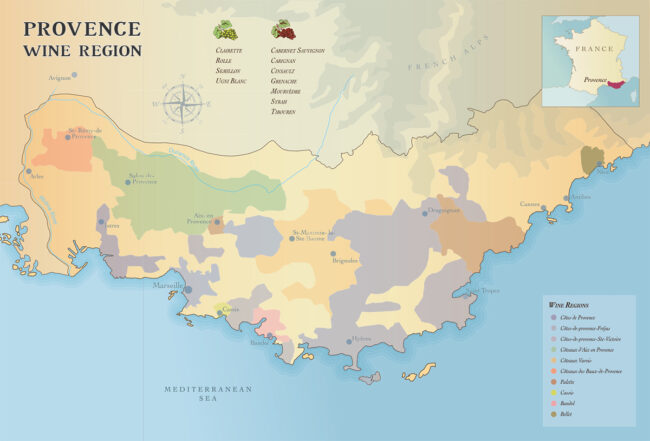
Bandol: Where Land Meets the Mediterranean Sea
It may be impossible to find a region where the winemaking pedigree is more impressive; Phoenicians were fermenting grapes here 2500 years ago, long before the Romans showed up and named the wine ‘Massilia.’ As the late-afternoon Bandol heat sends wafts of violet, black pepper and thyme into the air above an azure sea, it’s easy to see why this seacoast resort town has been both a destination and a home since prehistory.
About an hour’s drive east from Marseille, the microclimate that sets Bandol apart from the rest of Provence is the result of altitude and its natural amphitheater; the vines are planted on steep hills where the soils are composed of limestone, red clay and silica sand and the vines are protected from the harshest winds by the natural bowl formed in the low coastal mountain ranges between La Ciotat and Toulon. This combination of features makes it ideal for ripening finicky, late-budding Mourvèdre, which might otherwise be challenged by the proximity of the Mediterranean.
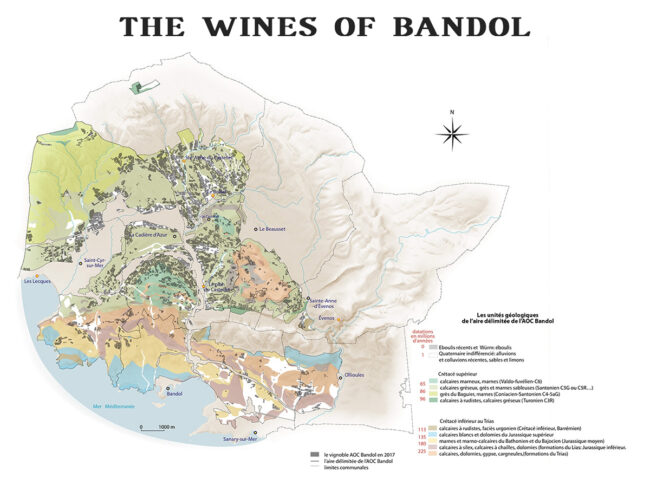
Bandol’s Signature Grape: Mourvèdre, Slow Burn
The ecological niche that makes Bandol’s Mourvèdre unparalleled in the world is the work of both man and nature. While Syrah and Grenache are planted on Bandol’s cooler, north-facing slopes, Mourvèdre is strategically placed on warmer, south-facing slopes to help nudge along the ripening process—the varietal is notorious for the time it needs to reach the level of phenolic ripeness required for the big, brooding, spicy, age-worthy reds for which the appellation is famous. Even so, the vines cling desperately to the slopes, making mechanical harvesting impossible. But hand-gathering is preferred in any case, ensuring a finer selection of grapes, in better condition and with smaller yields.
Meanwhile, the variety itself seems custom-designed for Bandol; Mourvèdre is an upright bush vine that forms a short stumpy trunk that will stand up to the Mistral winds. Bandol growers give preference to goblet pruning in order to reduce the amount of foliage and to help the low-producing vine bear triangular bunches with small, tight grapes bunches.
The Vigneron’s Savoir-Faire: Hard Road to Balance
To say that Bandol’s climate is ideal for Mourvèdre is not to say that growers have a smooth path to success: On the contrary, constant vigilance is table-stakes for successful winemaking operations; understanding the AOP regulations is a task in itself; following them is that much harder. For example, young vines intended for the production of red wines are not allowed to contribute until the eighth leaf has appeared on their trunk, and from that point, during every stage of cultivation, yields are controlled. Vine density must be at least 5,000 per hectare while spur pruning (leaving two-bud spurs on the trunk) is required. Chaptalization (adding sugar to unfermented grapes to increase the wine’s alcohol content) is banned, as is ‘any enrichment or concentration operation, even within the limits of the legal prescriptions in force.’
Things don’t get any easier in the cellar. Technology may have lightened certain workloads, allowing better control and new progress in quality, but the old ways reign supreme. Maturation is an essential factor in red wine production, and here, the vigneron’s know-how is irreplaceable. The primary goal in producing Bandol is to achieve balance through a process of slow, natural stabilization, and at each stage, wines are carefully selected and tasted and are accepted only if they meet the requirements of their status. A blind tasting test is carried out in June of the first year following harvest to allow the wine growers to examine the evolution of the vintage. It’s considered a ‘mock exam’ from which each wine grower learns critical lessons.
Future Classics in a Tuck-Away Pack
6 Bottles – $299 (Vintages 2021-2017)
Buying wine with the understanding that it will improve over time is like investing in stock futures: An examination of all the factors involved in the complicated process of wine maturity is vital. Not every Bandol from these four vintages are guaranteed longevity, but the ones we have assembled in this grouping have a high probability of improvement over the years—the result of terroir, the specifics of the growing season, and most importantly, the skill of the winemaker. Our trust in the latter is, though experience, impeccable.
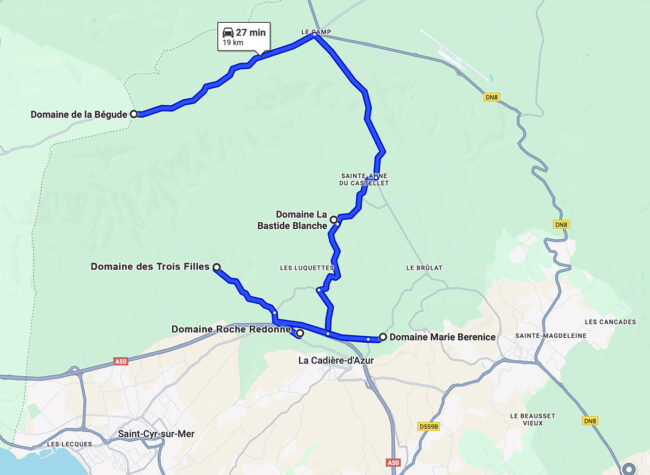
Notes on The Vintages
2021 — Bandol in Minor Key
Subtle, restrained, nuanced, savory and earthy.
——————-
An up and down vintage by all accounts, with late frost, early rain, middle-August heat and a quick spike in potential alcohol created conditions that produced Bandol reds with less potency than 2020, but plenty of nuance—savory herbs, iron and earth. Yields were down 20% to 25% from the previous harvest, which was already small, but the wine shows the potential for considerable improvement in the cellar.
2020 — Bandol in Full Voice
Bold, complex, powerful, built to last.
——————-
Significant rain in June and July allowed most of Bandol’s vines to skate through an extremely hot August without much stress. Grape sugars skyrocketed, however, necessitating a careful and fairly rapid harvest. Reds from this vintage show a signature reduction reminiscent of wines from the 1990s, adding complexity and signaling wine that will age well.
2019 — Bandol in Deep Harmony
Rich, resonant, firmly structured, long aging.
——————-
After a humid 2018, Bandol dried out, with hot conditions throughout the summer, significant sunshine and the welcome return of the Mistral wind helping to prevent mildew and concentrating juice behind thick Mourvèdre skins. These wines are rich and deep, exhibiting firm, ripe tannins and the capacity for long aging.
2017 — Bandol in Allegro
Quick tempo, early harvest energy, bright and brisk.
——————-
The third year of summer drought in Bandol meant small berries, small bunches and reduced yields; the harvest was 18% down from 2016. The early season and bright, hot summer also meant an extraordinarily early harvest, beginning August 11th in some places, and at least two weeks ahead of the previous average for warm or hot years. Tempier in Bandol began harvest on August 22nd and finished on September 12th, and was very pleased with the quality, suggesting that the Mistral had been critical in ensuring freshness in the fruit, and that the winter rains had also kept the vines healthy during the long, hot summer.
Domaine Marie Bérénic
Bandol at Its Primal Best
The first time Lyle Railsback, wine importer at France+Western tasted a bottle of Domaine Marie Bérénice, he exclaimed, “This Bandol Rouge has the aromas of Mourvèdre as thrilling as anything in Provence. And as exciting as older, cellared examples of Bandol can be there is something so captivating and primal about drinking a Bandol red on release, in its youth.”
As Domaine de Trois Filles was named for the daughters of the original owner, so is Domaine Marie Bérénice a tribute to Damien Roux’s daughter. Marie Bérénice was born into a long line of grape growers in Bandol, although historically the family sold their fruit to other estates. Damien, who made wine for another winery in the area, decided to begin releasing under his own label. The family farm, between the villages of La Cadière and Castellet and only a stone’s throw from the fabled beaches of Saint-Tropez, consists of 35 acres of clay and limestone terraces, where the work, done by hand, is certified organic.
In the cellar, Damien vinifies using wild yeasts and relies on long macerations. He ages his reds in large foudres for eighteen months before bottling without any fining or filtration.
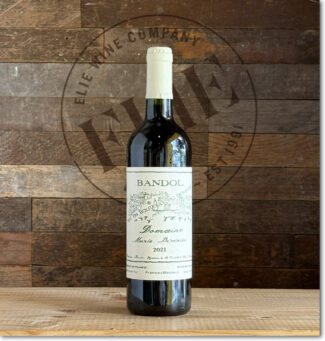 1 Domaine Marie Bérénice, 2021 Bandol ($33)
1 Domaine Marie Bérénice, 2021 Bandol ($33)
90% Mourvèdre and 10% Grenache. Pie spices and leather lend a savory profile while the fruit is filled in with vibrant notes of cranberry, blackberry and cassis, with cedar, and tobacco appearing on the finish.
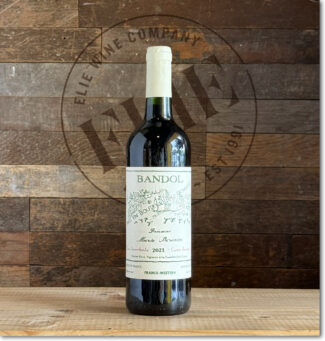 2 Domaine Marie Bérénice ‘Les Faremberts, Cuvée Simone’, 2021 Bandol ($36)
2 Domaine Marie Bérénice ‘Les Faremberts, Cuvée Simone’, 2021 Bandol ($36)
A collaboration between importer Lyle Railsback and Marie Bérénice’s winemaker Damien Roux, representing Damien’s oldest vines in a lieu dit known officially as ‘Les Faremberts’ but locally as ‘Chagall’ as the vineyard itself surrounds a family homestead owned by artist Marc Chagall. 90% Mourvèdre, 10% Grenache, the wine underwent a long maceration followed by 18 months in large oak barrels. A great, old-style Bandol showing cedar box, baking spices, blueberries and leather.
Domaine des Trois Filles
Bandol Takes Root in a New Generation
Audrey Arlon, current winemaker at Domaine des Trois Filles is one of the filles. The estate was named for her and her two sisters (Léonie and Justine) by their parents. Now, after having learned the craft and honed her skills at Domaine Ott and Domaine du Gros ‘Noré, Audrey has taken over her family’s vines in La Cadière-d’Azur.
“We farm 22 acres of old, goblet-trained vines co-planted with rye, fava beans, clover and radish sprout in between the rows,” Audrey explains. “This begins the process to combat global warming and keep the soil healthy. In the spring, we fold the cover crops into the earth to protect the soil while keeping humidity and maintaining a low temperature in the increasingly hot weather of Southern France. Giving natural aeration to the roots and better development of earthworms, we can to limit the spread of weeds, create greater biodiversity, and promote microbial life in the soil.”
Trois Filles is a family affair, and with the three sisters at the helm, it presents some interesting challenges. Audrey admits that it can be a struggle to balance the demands of motherhood with winemaking: “There are times, such as harvest, that require one’s full and undivided attention. And yet, from a physical point of view today, the evolution of the equipment allows us to force ourselves less, so we can do almost anything.”
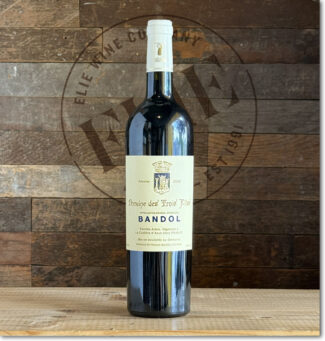 3 Domaine des Trois Filles, 2020 Bandol ($33)
3 Domaine des Trois Filles, 2020 Bandol ($33)
75% Mourvèdre, 20% Grenache and 5% Cinsault from goblet vines grown on a clay-limestone hillside. Hand harvested into crates, gently macerated with native fermentation in stainless steel and aged in barrels for 18 months. A muscular core of earthy dark fruit is highlighted by classic leather, garrigue, underbrush and sweet black raspberry notes.
Domaine Roche Redonne
Bandol Anchored in the Hills, Bathed in Garrigue
Founded in 1979 by Henri and Geneviève Tournier, Roche Redonne is situated among the Bandol foothills surrounded by olive groves and garrigue scrub just outside the pretty village of La Cadière d’Azur.
The 30-acre vineyard is farmed using organic methods and the vines now average more than 40 years in age, with the youngest vines at 20 years and the oldest at 60. The yields are kept low, and, in fitting with the appellation laws, the steeply hilled vineyards is harvested by hand.
Their son, Guilhem Tournier, has followed in their footsteps, creating his own estate (Château Guilhem Tournier) in 2004 and is now fully certified organic and he uses biodynamic methods.
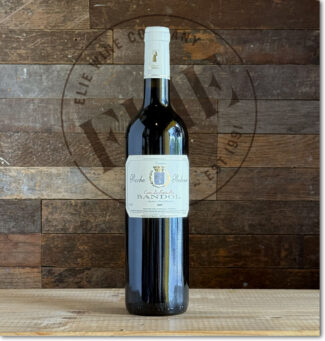 4 Domaine Roche Redonne ‘Cuvée Les Bartavelles’, 2019 Bandol ($71)
4 Domaine Roche Redonne ‘Cuvée Les Bartavelles’, 2019 Bandol ($71)
‘Bartavelles’ means ‘Royal Partridges,’ and it certainly presents a noble expression: 95% Mourvèdre and 5% Grenache grown on a blue marl base with a layer of clay on top. The wine offers a fruity aroma with a hint of smoke; the palate is filled with cherry compote and sweet spices, leading to a full, textured finish of exceptional length.
Domaine La Bastide Blanche
Bandol on the Rocks, at the Edge of the Sea
Michel and Louis Bronzo purchased Bastide Blanche in the ‘70s in the belief that the terroir could produce a wine to rival those of Châteauneuf-du-Pape. With that in mind, the brothers planted Carignane, Cinsault, Clairette, Grenache, Mourvèdre and Syrah. Vintage 1993 proved to be their breakaway year, putting both Bandol and themselves on the wine map. The estate is located in the foothills of Sainte-Baume Mountain, five miles from the Mediterranean Sea on land that is primarily limestone scree.
Bastide Blanche has been certified Biodynamic since 2020. According to Louis Bronzo, “True to our terroir, all our wines are organic and Biodyvin certified. To preserve nature and protect everyone’s health, we work tirelessly to improve our farming practices. We owe the earth our loyalty, especially since we have blessed with our environment, at the foot of the Sainte-Baume mountain, just a few kilometers from the Mediterranean Sea. Our soil is predominantly limestone, which is ideal for our dozen grape varieties.”
Michel adds, “As is required of Bandol producers, all our grapes are harvested by hand—a practice that makes it possible to finely sort the bunches during harvest and to better protect the fruit until it reaches the cellar.”
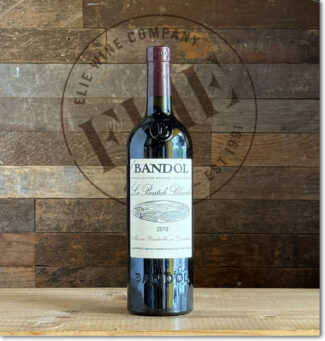 5 Domaine La Bastide Blanche, 2019 Bandol ($34)
5 Domaine La Bastide Blanche, 2019 Bandol ($34)
Predominantly Mourvèdre (around 73%) with smaller contributions by Grenache, Cinsault, Syrah and Carignan, the wine is Bandol-big with crushed blackberries, raspberries and warm cherry pie. Lively, mouthwatering and concentrated with great mid-palate intensity.
Domaine de La Bégude
Bandol on High Ground
Located at the highest point in Bandol (1400 feet) La Bégude was once a stopover inn on the road from Marseille to Toulon, a shelter for the night where you could find ‘beguda’—the local Provençal wine with a name drawn from the Catalan language.
The Roulleau family purchased Domaine de La Bégude in 2022, making them only the fifth family to own the estate since the Middle Ages. Appointing Laurent Fortin as Managing Director. According to Fortin, the goal in overseeing the estate is “To keep the same pioneering spirit while daring to break the codes to offer a unique vision of wine in the heart of this exceptional vineyard.”
Fortin, who has managed Roulleau-owned Château Dauzac since 2016, says, “The Roulleau family fell in love with this site, these exceptional terroirs set in the garrigue and these wines with strong personality. We are following in the footsteps of the Tari family to make La Bégude shine at the top of the Bandol appellation. The challenge is exciting, in the continuity of Château Dauzac, to build a family group of inspired vineyards.”
The synergy between the Tari and Roulleau clans has been immediately apparent, both in viticultural dynamism and in the spirit that shares the common value of respect for nature and biodiversity. Under the Tari family, Bégude was a place of natural agro-forestry, home to the International Conservatory of Mourvèdre, which farms an exceptional vine collection of 150 Mourvèdre varieties, the largest in the world. Going forward, the intention is to reinforce and maintain this collection.
The estate itself encompasses more than 1200 acres, of which 75 are under vine—65% Mourvèdre, 25% Grenache and 10% Cinsault, now at an average age of 25 years. The vineyards sit at elevations exceeding 1300 feet, and as such, are among the highest in the appellation. The plan is to increase the cultivation to 100 acres over the next few years and to continue to produce Bégude’s hallmark rich, acidic, fruit-driven wines that develop in the cellar with elegance. The Roulleaus are proud to age their own wines in the old chapel of Miséricorde of Conil, dating from the 7th century—a vestige of the presence of the Abbey of Saint Victor on the estate.
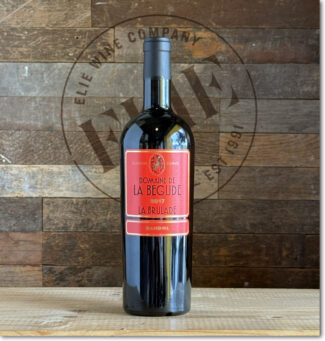 6 Domaine de la Bégude ‘La Brulade’, 2017 Bandol ($99)
6 Domaine de la Bégude ‘La Brulade’, 2017 Bandol ($99)
95% Mourvèdre, 5% Grenache grown on clay marl. ‘La Brulade’ is the name of a select slope located at an altitude of 1300 feet overlooking the Mediterranean Sea between La Baie d’Amour in the south and La Sainte Baume in the north, one of the highest parcels in Bandol; the wine is only made in exceptional vintages. With 24 months of foudre aging behind firm and tannic fruit, the wine is dark and brooding and shows blackberry, boysenberry, licorice and peppery garrigue. It should continue to develop nuance for years to come.
Bandol Matured, Time Realized
Superlative winemaking involves a formula that’s part science and part soul. It’s not a stretch to liken the process to a recipe, and so a comparison of a great wine with the steps required to produce a perfectly prepared, top-end Wagyu ribeye steak is appropriate. Like wine, an exceptional piece of beef traces its origins to the earth itself: Wagyu cattle are pampered from birth, fed a high-protein diet, often massaged and given beer to encourage marbling.
Likewise, the vineyards that produce top quality wines enjoy both breeding and babying; adding to the natural elements is a cycle of biodynamics to mollycoddle microbic life, with the correct attention paid to moisture, food and pruning. While in the growth stage, all possible care is taken so that the vines do not fall prey to disease or mismanagement.
The same holds true for the steer. And for both, some aging is required before premium flavor is said to be reached. For the Wagyu, this may be as long as four hundred days at 34°F; for the aged Bandol’s in this week’s package, the wine wettest behind the years is eight years old; the most mature, 15.
Of course, for both beef and bottle, the consumer is the ultimate benefactor and the decisive judge; the time the wine spends maturing toward an ‘ideal’ state is the time the steak spends over the flame. This is, of course, an optimal and somewhat measurable period depending on individual tastes, but a given consensus can certainly be formed and debated.
A gustatory exploration of these wine selections (which happen to pair very well with beef) bears witness to the evolution of Mourvèdre and Cinsault and to a lesser extent, Grenache and Syrah in Bandol’s changing climate. The sensory profile of this blend has developed a kaleidoscope of tertiary flavors and scent developments.
Provenance is guaranteed for these wines, of course, so you know that storage conditions have been optimal.
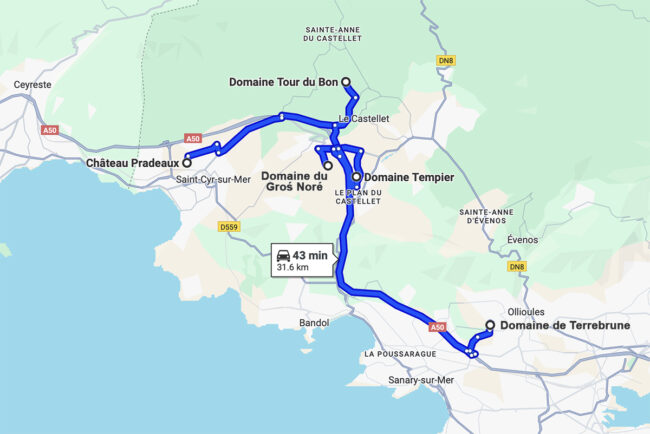
Notes on The Vintages
2016 — Bandol in Sustained Note
Concentration, freshness, built for endurance and the long haul.
——————-
Aside from a minor frost in April, the main growing-season challenge was drought: in Bandol, fewer than eight inches of rain throughout the entire season. The result was a reduction of yields of 10 to 30%. The quality of both white and (especially) red wines, though, was high since the summer heat was tempered by cool nights and the grapes retained fresh acidity, while the lowered yields provided impressive concentration of flavor. These are wines for the long haul.
2015 — Bandol in Allegretto
Balanced, graceful, approachable yet with poise.
——————-
The second wet winter in a row raised water tables to herald a warm, dry spring. Bud break took place earlier than usual and flowering went well; summer was generally warm but without excessive heat—the rain that fell on June 15th was helpful. The conditions of steady, tempered heat continued throughout August clear skies; Bandol reds are outstanding. Drink now, or hold for a few more years.
2013 — Bandol in Andante
Measured pace, delicacy, freshness, middle-weight charm.
——————-
After a long, cool and slow spring, the entire growing season—bud break, flowering, véraison and harvest—was about two weeks later than usual. There were a few hail storms in June, but the disease pressure of early summer gradually abated thanks to the Mistral as September approached. It was a good vintage for those who long for delicacy and freshness in white and rosé wines, but the reds tended to be middle-weight and are probably at their peak.
2011 — Bandol in Counterpoint
Contrasts resolved into structure, now showing maturity.
——————-
A dry, sunny spring led to ideal flowering, but the summer was uneven with a cool wet July, dry conditions from mid-August to mid-September. Then welcome rain fell followed by drying Mistral wind. Cool nights during harvest led to Bandols being particularly successful & structured; best required cellaring and are now coming into their own.
2010 — Bandol in Adagio
Late harvest, spice and finesse, graceful and nuanced.
——————-
Bandol saw more rainfall than recent years with sporadic flooding in June. Alternating sun/rain in October resulted in late, extended harvest led to Bandol reds with much spicy finesse and definition.
Château Pradeaux
Resolutely Old School
Situated on the outskirts of the town of Saint Cyr-sur-Mer, directly on the Mediterranean between Toulon and Marseilles, Château Pradeaux has been in the hands of the Portalis family since the French Revolution. In fact, Jean-Marie-Etienne Portalis helped draft the Napoleonic Code and assisted at the negotiation of the Concordat under Napoleon the First. Today, the domain is run by Cyrille Portalis, who continues to maintain the quality traditions of his forbears, assisted by his wife Magali, and their sons Etienne and Edouard. Although vineyards are planted almost exclusively to old-vine Mourvèdre, Château Pradeaux Bandol Rosé is composed of Cinsault as well.
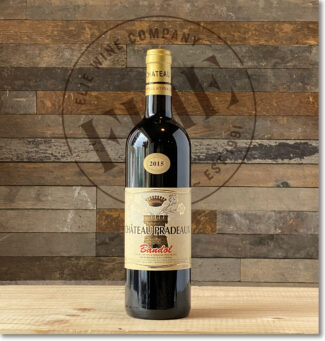 Château Pradeaux, 2015 Bandol ($67)
Château Pradeaux, 2015 Bandol ($67)
95% Mourvèdre, 5% Cinsault. In contrast to the three years preceding it, the 2015 vintage yielded a classic and deeply typical Pradeaux Bandol: a wine of grainy, spicy fruit, medium in weight but rippling with underlying power, and with an intoxicating aromatic overlay of violets and smoked meats.
Domaine de Terrebrune
Bandol’s Creed of Soil and Soul
Owning a winery may be the whispered dream of many sommeliers, but Georges Delille put his francs where his mouth was. In 1963, he bought an idyllic property in Ollioules, just east of Bandol, framed by the Mediterranean and the Big Brian mountain (Gros-Cerveau). The site was dotted with olive groves and scenic views, but no vines. Georges spent ten years renovating the property; he terraced hillsides, refashioned the masonry, replanted vineyards following the advice of Lucien Peyraud, designated soils to lie dormant and regenerate, and built a new cellar. In 1980, his son Reynald joined him after attending winemaking school, and together they launched their first bottled vintage of Domaine de Terrebrune, which Reynald named in honor of the rich, brown soils they farm.
There is plenty of diversity in this soil, though. Throughout Terrebrune’s 75 acres, beneath the layers of clay and earth, blue, fissured limestone is at work, lending a more noticeable minerality to the wine. Reynald’s personal credo of “Philosophy, rigor, and respect” is not a catch-phrase, but an ideology for living.
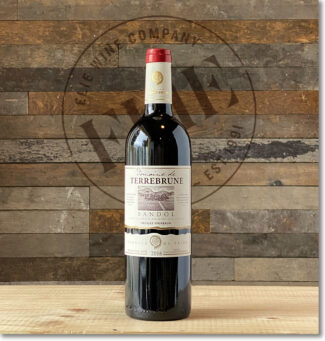 Domaine de Terrebrune, 2016 Bandol ($64)
Domaine de Terrebrune, 2016 Bandol ($64)
85% Mourvèdre, 10% Grenache, 5% Cinsault grown in limestone-pebbled brown clay above blue limestone bedrock. A full-bodied dose of Terrebrune terroir that should continue to mature and drink well for another two decades. Shows blackberries, dark cherries and cedar with hints of black pepper, game, licorice and dark chocolate.
Domaine Tempier
Bandol’s Single Vineyards, Etched in Stone
Robert Parker Jr. once referred to Domaine Tempier’s rosé as ‘the world’s greatest’, but the backstory isn’t bad either: Gifted the property by her father in 1936 upon her marriage to Lucien Peyraud, Lucie ‘Lulu’ Tempier found herself the owner of an active Bandol farm near Le Plan du Castellet that had been in the family since 1834. Her husband did extensive research into the terroir, and immediately halted the ongoing effort to tear out Mourvèdre vines in favor of higher-yielding varieties. In went new Mourvèdre, some of which are still producing.
With the assistance of neighboring vignerons, Lucien worked with the I.N.A.O. to establish Bandol as its own AOC, whereupon a large-scale replanting of Mourvèdre ensued across the region. As a result, Lucien will forever be celebrated as the Godfather of Bandol as well as the man who revived Mourvèdre to its former glory. Part of that glory includes their three single-vineyard releases, La Migoua, La Tourtin, and Cabassaou.
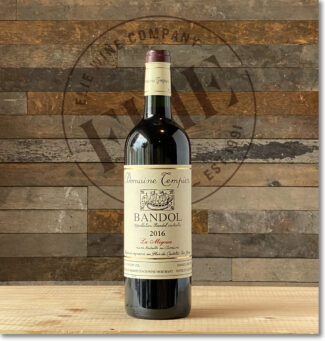 Domaine Tempier ‘La Migoua’, 2016 Bandol ($110)
Domaine Tempier ‘La Migoua’, 2016 Bandol ($110)
50% Mourvèdre, 20% Grenache, 26% Cinsault, 4% Syrah. La Migoua’s terroir mainly consists of heterogeneous clay that varies in color between red, ochre, and blue. Located at 885 feet, it is the highest altitude vineyard among all of Tempier’s sites. The 60 acres are bordered by garrigue and pine forest, and the grapes yield earthy, gamey wines. La Migoua has the smallest proportion of Mourvèdre in the blend, with the highest percentage of Grenache among the three cuvées.
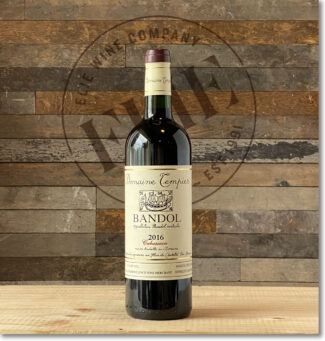 Domaine Tempier ‘Cabassaou’, 2016 Bandol ($160)
Domaine Tempier ‘Cabassaou’, 2016 Bandol ($160)
95% Mourvèdre, 4% Syrah, 1% Cinsault. At 4 acres, Cabassaou is the smallest Tempier vineyard, but with the oldest vines, now surpassing fifty years. It sits lower on the hillside where it is protected from the strength of the Mistral, enjoying temperate breezes and maximum sunshine, which is evidenced by is ripeness, density and power in the wines.
 Domaine Tempier ‘La Tourtine’, 2016 Bandol ($110)
Domaine Tempier ‘La Tourtine’, 2016 Bandol ($110)
80% Mourvèdre, 10% Grenache, 10% Cinsault. La Tourtine sits just above Cabassaou, where the soil is more homogeneous and rich with clay. As a result, the 30-acre La Tourtine produces powerful, tannic wines with gorgeous fruit character.
Domaine du Gros ‘Noré
Mourvèdre with Muscle
‘Gros’ means big, but as for ‘Noré, the translators are silent. But ‘big’ is the operative word anyway since it describes the proprietor in body, mind and legend. A former boxer and an avid hunter, Alain Pascal spent many years as a grower who sold his Bandol fruit to Domaine Ott and Château de Pibarnon. Along with his father, he bottled wine for family consumption only. But in 1997, after his father’s death, Alain launched Domaine du Groś Noré, and now, along with his brother Guy, bottles 5000 cases annually drawn from his forty acres of prime Cadière d’Azur vineyard.
The brothers work within the strictures of the region and often, beyond them, leaving the grapes to mature fully on the vine, lending great intensity to the fruit, and where appellation law demands that each blend includes at least 50% Mourvèdre, Alain ups the assemblage ante to 80%. The wine reflects the man; big and bold up front, while underneath is a core of character—depth, complexity, soul and finesse.
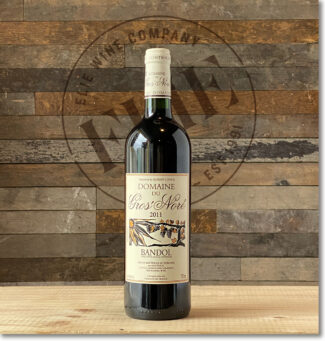 Domaine du Gros ‘Noré, 2011 Bandol ($98)
Domaine du Gros ‘Noré, 2011 Bandol ($98)
80% Mourvèdre, 15% Grenache, 5% Cinsault. The 35-acre vineyard contains vines of about 30 years in age. With a decade under its belt, the harsh tannins have softened and the wine has given over its aggressive fruit to cool notes of eucalyptus and fresh fennel.
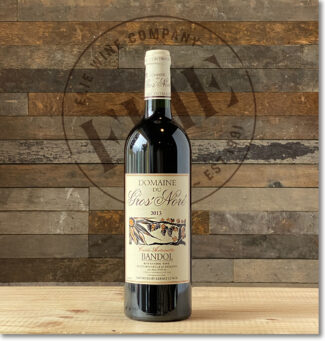 Domaine du Gros ‘Noré ‘Cuvée Antoinette’, 2013 Bandol ($120)
Domaine du Gros ‘Noré ‘Cuvée Antoinette’, 2013 Bandol ($120)
95% Mourvèdre, 5% Cinsault/Grenache. A beautiful blend with hints of underbrush and mushroom behind the dark red fruits and spice. The tannins are resolved and the acidity is suitably tempered.
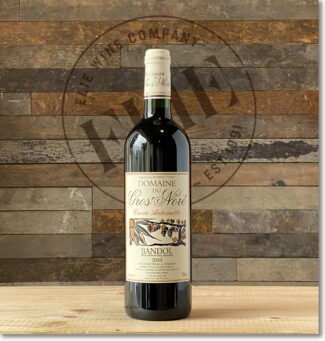 Domaine du Gros ‘Noré ‘Cuvée Antoinette’, 2010 Bandol ($130)
Domaine du Gros ‘Noré ‘Cuvée Antoinette’, 2010 Bandol ($130)
95% Mourvèdre, 5% Cinsault/Grenache from a small, two-acre vineyard. Black cherry and stewed plum notes remain to enliven balsa, tobacco, game, graphite and iron.
Domaine de la Tour du Bon
A Lyrical Bandol From the Heights
Sitting pretty at an elevation of 500 feet on 35 acres of red earth, clay, sand, and gravel over a sturdy limestone plateau in Le Brûlat du Castellet in the northwestern corner of Bandol, Domaine de la Tour du Bon is the culmination of commitment and sweat equity. The property, cleared by plough, has been a full-time farm since 1925 and has been worked by the Hocquard family since 1968. At the helm is Agnès Henry, who spent a number of years at the apron strings of a hired winemaker, but when she decided to approach the job herself, she found that her person expression of terroir was quite unique. The wines she claims as her own have both power and precision in equal measure, but effectively display the finesse and charm of her lyrically named vineyards, La Rémoise (The Dweller), Saint Ferréol (a local saint), Ensoleillade (Place Bathed in Sunshine), Clos des Aïeux (Clos of the Forefathers), l’Aire (the Aerie) and Bellevue (Beautiful View).
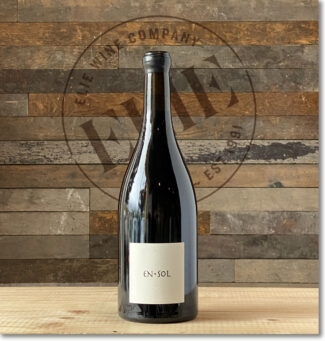 Domaine de La Tour du Bon ‘En Sol’, 2017 IGP Méditerranée ($85)
Domaine de La Tour du Bon ‘En Sol’, 2017 IGP Méditerranée ($85)
A half-acre site produces this extraordinary non-blended Mourvèdre, but since it breaks Bandol AOP regulations requiring a two-grape minimum, Henry has chosen to declassify the wine and release it as IGP Méditerranée. Grippy yet accessible tannins underscore flavors of ripe dark fruit, berries, scorched earth and a touch of smoked meat.
Notebook …
Mourvèdre in the Hot Seat: Bandol and the New Provence
For as long as anyone can remember, Bandol has been the outlier of Provence. Where the rest of the region turned its vineyards into a factory of pale, pool-side rosé, Bandol doubled down on Mourvèdre—a grape that doesn’t like to be rushed and doesn’t care if you’re impatient. It needed heat, sun, and time. Plenty of time.
That was then. Now, thanks to climate change, Bandol has more heat than it knows what to do with. Harvest comes weeks earlier, sugars spike, and bottles that once clocked in at 13% creep toward 15%. What used to be a wrestling match to ripen Mourvèdre has become a struggle to rein it in.
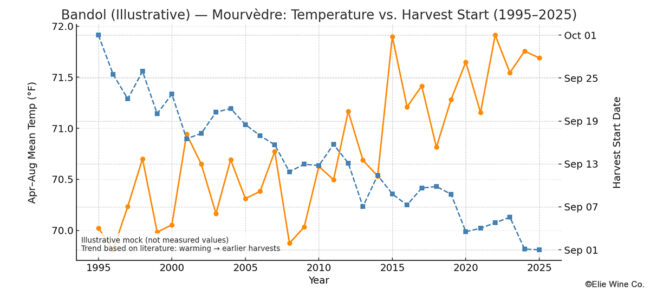
The New Reality Check
Bandol’s growers are staring down a paradox. Mourvèdre—once the slowpoke grape that barely made it to the finish line—is suddenly sprinting. Power is easy. Balance? That’s the endangered species. And the vineyards themselves are thirsty. Longer droughts stress even Bandol’s famously deep-rooted old vines, while the rain, when it does come, arrives as a downpour that chews up terraces and washes away topsoil.

Rosé Isn’t Immune
Even Bandol’s rosé, the muscular cousin of Provence’s whisper-pale styles, is shifting. Deeper colors, bigger fruit, the kind of aromatics that read more tropical cocktail than Provençal picnic. Some drinkers cheer the intensity; others miss the quiet elegance that once defined Bandol’s pinks.
Coping Mechanisms
Growers are improvising. Taller canopies to shade the bunches. North-facing sites and higher altitudes to slow things down. A little more Grenache or Cinsault in the blend to sand down Mourvèdre’s rough edges. Longer élevage in big foudres to bring back some discipline.
Bandol on the Edge
The question hanging over all of this: What does Bandol look like in 20 years? A Mediterranean powerhouse pushing 16% alcohol, or a region that manages to bend without breaking, reinventing itself while staying true to its granite-jawed personality?
Bandol has always been about tension—between sun and wind, fruit and tannin, pleasure and patience. Climate change doesn’t erase that tension; it cranks it up. The wines may be louder now, but they’re still telling the same story: Mourvèdre doesn’t compromise, and neither does Bandol.
- - -
Posted on 2025.09.18 in Bandol, France, Wine-Aid Packages, Provence | Read more...
Savoie Fare: Father-and-Son Duo Jean-Noël & Thomas Blard Craft Distinctive, Instantly Appealing Wines from Rare Alpine Varieties in France’s Mountainous Savoie Region 7-Bottle Red, White & Sparkling Sampler – $279
Italy is one giant vineyard, cuff to heel, but in France, wine regions are like fireflies in a midnight garden; they light up isolated corners. The brightest fireflies command most of the attention, of course, and as a result, the highest price points. But Savoie—in the far eastern part of France where the Alps spill over from Italy and Switzerland—is one of most remarkable of the glimmers.
The White Stuff: A Golden Opportunity Leads to Wine Revival
According to Wink Lorch, an avid skier and arguably Savoie’s most vocal champion, the development of the post-war ski industry represented a turning point for the region’s popularity: “This created new customers for its wines, of which very little get exported. Even so, up until the 1970s, there were hardly any vine-growers who lived solely from their vines.”
Reconquering the Slopes
Over the past twenty years, however, a new wave of independent vignerons has been boosted by organizations dedicated to preserving the singular grape varieties of the region, and Savoie has finally begun to come into its own.
Alpine wines have a crunchy sizzle and a cool sappiness unlike wine from anywhere else. Not only that, but the predominant grapes don’t show up on many other radars, so the unique textures commingle with a whole new flavor profile to surprise and delight the palate.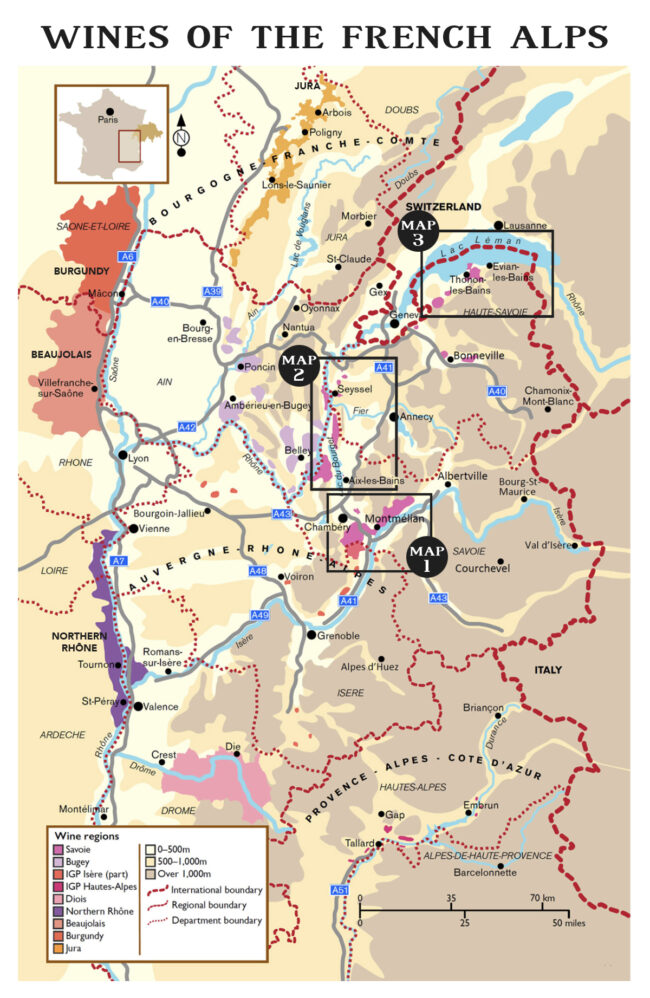
For the historically inclined, Savoie was the point where Hannibal crossed the Alps en route to Rome; for vinophiles, Savoie encompasses two main sub-appellations—Bugey, with 1250 acres of vines and Vin de Savoie, or simply Savoie AOP, which includes Roussette de Savoie and Roussette du Bugey. There are also 17 Vin de Savoies Crus and four Roussette de Savoie Crus, whose name may appear on labels. Most Savoie vineyards are planted on steep, south facing slopes, where favorable sunlight exposure and excellent drainage make for perfect ripening conditions despite the cold continental climate. The presence of lakes Bourget and Geneva, as well as the upper Rhône River, further moderate the climate. Most Vin de Savoie vineyards are found on limestone-based soils, which is adept at storing heat during the day and reflecting it back onto the vines at night.
Wines That Refresh Like Mountain Air: The Cool Signature of Alpine Terroir
Metaphors linking wine to its place of origin are the stuff of poetry, but they’re also the foundation of terroir. Among the most common descriptors of high-altitude wine is ‘refreshing’ which is an offhand way of saying that they tend to be lower in alcohol and higher in acidity than valley wines. These acids are often the end result of the cool mountain air which they resemble, giving distinct, cleansing mineral characteristics to the wine with citrus and herbs rather than jammy fruit.
Savoie’s Natural Balance: Interplay Between Acidity and Lightness
That said, it is sometimes a challenge for winemakers to reign in mountain-borne acid and to keep it from running away with the profile. Tart is acceptable—sour is not. Without delving into too much chemistry, the predominant acids found in wines are tartaric, malic, citric and succinic, and all but the last occur naturally in grapes—succinic acid is produced by yeast during fermentation. In areas where long hang-times for grape bunches to develop sugars and tame acidity are not possible in the mountains, and winemakers will occasionally resort to artificially manipulating the juice, the must, or as a last resort, the finished wine.
These are not wines we embrace at Elie’s, preferring those that display natural balance, favoring the expression of terroir over excessively extracted fruit with high sugar levels. Adjusting acid rather than preserving it defies one of winemaking’s oldest adages: ‘Good wine is made in the vineyard, not in the cellar.’
The wines of Savoie (even the reds) tend be light and somewhat playful on the palate, filled with alacrity and crackle and with correspondingly low alcohol levels to match an ethereal mountain finesse. Yet, we have found many wines of Blard & Fils that seek to take traditional Savoie varietals to the next level, busting through the clichéd ‘Ski & Raclette’ ceiling to create sophisticated wines suitable for the most refined tables.
Seven-Bottle Sampler Pack $279
The wines in this 7-Bottle Sampler Pack represent one of Savoie’s icons and iconoclasts, Thomas Blard, who has taken the management reins from his father Jean-Noël. They represent the wide array of native grapes and their associated flavor profiles that are typical of this hinterland of marvels.
Setting the (Appellation) AOP Scene:Savoie & Roussette de Savoie
Located in the foothills of the vast Alpine ranges of Switzerland and Italy, Savoie AOP grows grapes at altitudes between 800 and 1800 feet. Savoie’s 11,300 acres of scattered vineyards are responsible for less than 0.5% of the wine produced in France, and of the 3 millions of wine made in Savoie every year (compare this to Bordeaux’s 158 million), only about 8% of it is consumed outside the appellation. Although even the highest vineyards are at foothill-elevation, the region is distinctly alpine, with towering white-capped mountains and pristine lakes dominating the surrounding terrain: Mont Blanc, France’s tallest peak at 15,000 feet, has a Savoie zip code. The vineyards are adapted to this environment, growing occasionally on 80-degree slopes. Ranging from rocky subsoil to sand (sometimes in the same vineyard) the Savoie terroir supports 23 different grape varieties.
A large portion of western Savoie falls under the sub-appellation Roussette de Savoie. Encompassing four Cru communes—Frangy, Marestel, Monterminod and Monthoux—Roussette wines are dry and made from the Altesse grape, here is called ‘Roussette.’ The name is a reference to the reddish tint that the grape acquires before harvest.
In the past, Chardonnay made up to half the content in Roussette bottlings, but the practice was outlawed in 1999.
Domaine Blard et Fils
Abymes, Apremont, Arbin, Roussette de Savoie
Apremont is perhaps the best known white wine Cru in Savoie. Surrounding the tiny village of Apremont, just south of Chambéry, the vines make up one of the most southerly Crus in the department. Apremont wines are made predominantly from the local Jacquère grape and are typically light and dry with floral, mineral characters.
In part, Blard & Fils is hard at work changing preconceptions about this terroir.
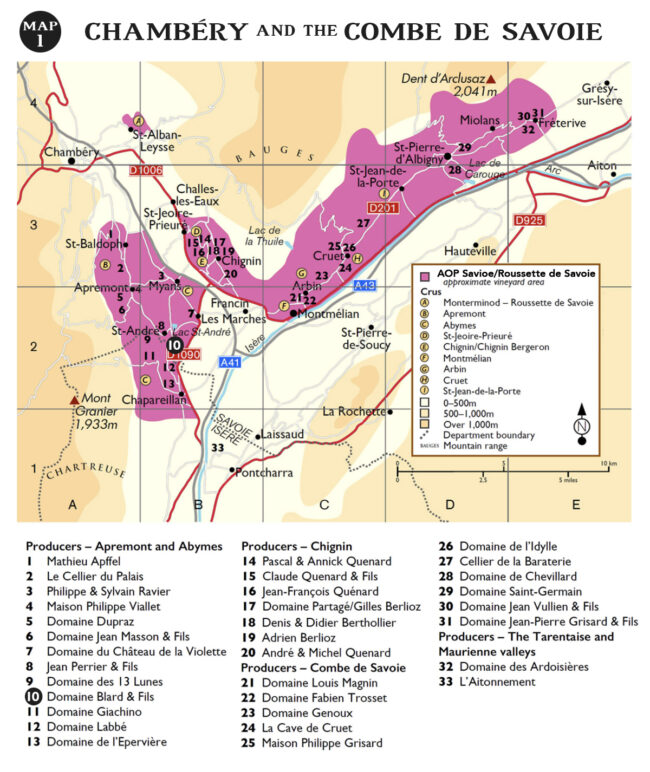
Jean-Noël and Thomas Blard are a father/son team who has taken their family domain to new quality heights while moving steadily toward fully organic and natural viticulture. In the 1990’s, Jean-Noël became one of the first vignerons in the appellation to diversify into Pinot Noir, and was also eager to raise the quality bar on Jacquère and Mondeuse—the latter by aging in neutral oak for a minimum of two years. With 25 acres under Blard control, grassed over and fertilized naturally, the Blards use a technique known as ‘intercep’ to remove unwanted greenery before finishing the job by hand.
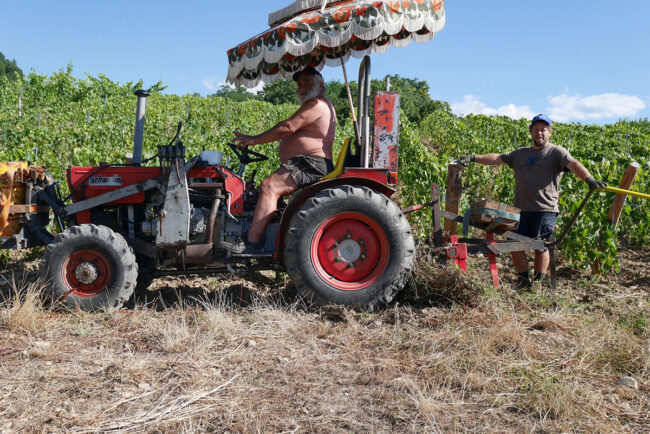
Jean-Noël and Thomas Blard, Domaine Blard & Fils
Five generations of Blard have snatched victory from the jaws of defeat: In 1248, the side of Mont Granier (one of the major formations of the Savoie’s Chartreuse Massif) collapsed, and a wave of boulders and scree crushed the landscape below, forever changing the soil structure. Apremont means ‘bitter mountain’ and Abymes means ‘ruin’ and as a result of the natural upheaval, it is today it is considered to be the best place in the Savoie (and by extension, all of France) to grow Jacquère.
Altesse: Her Highness’ s Balancing Act
Nowhere in the world does Altesse reign as regally as in Roussette de Savoie, an AOP which has adopted the grape’s nickname ‘Roussette’ as its own. Late to ripen, and turning pink near harvest, the variety produces small grapes with a tight-bunch structure. Its most significant success is as a stand-alone varietal (chiefly in Roussette de Savoie and Roussette du Bugey), but it is also permitted as a minor blending component in the Jacquère-predominant Vin de Savoie wines.
The most likely origin theory is that Altesse is indigenous to the southern shores of Lake Geneva since it shares a close genetic link to the western Swiss workhorse Chasselas. Altesse is perfectly suited to the mountainous terroir around the western Alps in Savoie, and retains a high level of acidity while developing characteristic flavors of bergamot, hazelnut and almond. Such characteristics make it ideal for the production of sparkling wines as well and, consequently, Altesse is included in the region’s Crémant de Savoie wines and the sparkling Seyssel wines. Still Altesse wine is sometimes aged in oak and can age in bottle for up to five years.
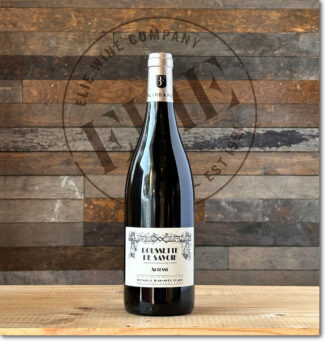 1 Blard & Fils, 2020 Roussette de Savoie ‘Altesse’ ($27) WHITE
1 Blard & Fils, 2020 Roussette de Savoie ‘Altesse’ ($27) WHITE
100% Altesse from Abymes, from vines that are 35 years old. As always, Thomas Blard ferments naturally, with 20% of the juice seeing skin contact for 10 days. Aged on the lees for 10 months before bottling, the wine presents a terrific nose of green grass, salt, lemon and ripe apricot. The palate follows with green tea, lime zest, and herbs behind an exhilarating, Chablis-like texture.
Jacquère: Defined by Salinity and Minerality
Jacquère’s pedigree is 100% Français, and specifically Savoyard—at least, it’s impossible to find significant plantings outside the shadow of Mont Granier in the villages of Apremont and Abymes. The wines have characteristic cool-climate acidity vines and they write the book on the classic descriptors ‘mountain fresh’ and ‘alpine clean.’ Leaning toward the herbaceous with showers of freshly cut grass, green apples and pears, Jacquère is usually best when consumed young, while it still displays clean minerality and lively citrus palate.
It’s a high yielding vine, something that does not always lend itself to high quality. Since the 1980s, an attention to wine made from limited yields has resulted in wines with considerably more depth and weight, showcasing the region’s potential.
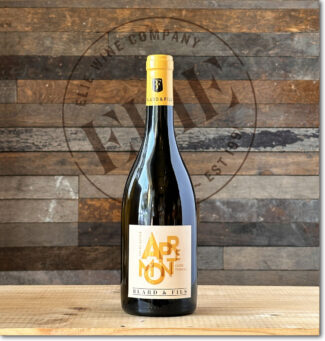 2 Blard & Fils ‘Cuvée Thomas’, 2021 Vin de Savoie Apremont ($29) WHITE
2 Blard & Fils ‘Cuvée Thomas’, 2021 Vin de Savoie Apremont ($29) WHITE
Cuvée Thomas is a blend of several different Jacquère parcels where vines are between 36 and 120 years old. Grown on clay/limestone soils seasoned with blue silex, the grapes are fermented on native yeast and aged ‘sur lie’ for nine months prior to bottling. The wine shows a delicate fresh almond bouquet above a foundation of crisp apricot and peach, with a mineral-driven palate that expresses textbook Jacquère salinity.
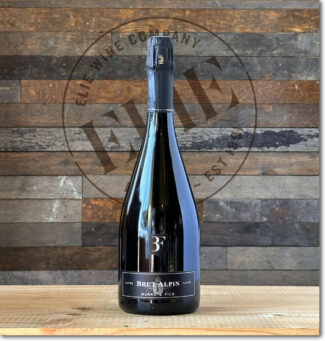 3 Blard & Fils ‘Alpin’, Crémant de Savoie Brut ($32) SPARKLING WHITE
3 Blard & Fils ‘Alpin’, Crémant de Savoie Brut ($32) SPARKLING WHITE
50-year old Jacquère (60%), Chardonnay (20%) and Pinot Noir (20%) vines from an ideally exposed south-east facing vineyard, the base wine was aged for eight months in a combination of barrels and vats; once bottled, this Brut-nature zero-dosage sparkler sees an additional 24 to 36 months aging. Disgorged January 2022.
Malvoisie: From Mistaken Identity to Savoie Original
Lesson one is offered by INAO, the organization that defines appellations in France: Malvoisie does not belong to the Malvasia family, which produces many forgettable wines throughout the Mediterranean, including Pinot Grigio. Instead, it is Frühroter, a cousin to Austria’s famous Grüner Veltliner. It resembles Pinot Gris on the vine, and since Malvoisie was not, until recently, approved for Savoie, many growers simply labeled their Malvoisie ‘Pinot Gris.’
The second lesson comes from Thomas Blard himself: “Our Malvoisie is the real deal; Frühroter Veltliner and never Pinot Grigio.”
Frühroter Veltliner wines tend to be somewhat herbaceous with light lemony characters and often a note of almonds. It is an early ripening grape susceptible to frost, which accounts for the prefix ‘früh’, which means ‘early’ in German.
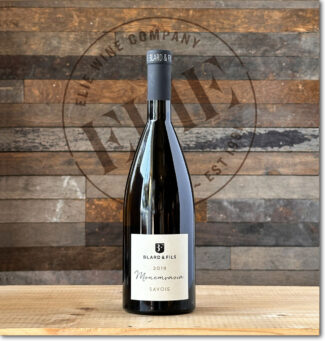 4 Blard & Fils ‘Monemvasia’, 2019 Vin de Savoie ($32) WHITE
4 Blard & Fils ‘Monemvasia’, 2019 Vin de Savoie ($32) WHITE
Thomas Blard does not make ‘Monemvasia’ every year; it is entirely dependent on the success of the harvest. Instead, in some years, Thomas and Jean-Noël do a sweet wine from the grape using ‘passerillage,’ the technique of drying the grapes in ambient air to concentrate sugars.
2019’s ‘Monemvasia’ is dry. It originates from 10-year-old vines from three different parcels with a mix of clay and limestone soils where elevations average 1200 feet. The wine, which shows delicate cucumber, Meyer lemon, and crisp mineral tones, was vinified in stainless steel tanks and aged 12 months in stainless and from Crémant.
Mondeuse Noire: Savoie’s Distinctive Red with a Syrah Connection
Mondeuse Noire, commonly known simply as Mondeuse, is a grape with a distinctive personality. Having likely originated in eastern France, probably in or close to the region it now calls home, Savoie, it was once thought that Mondeuse was identical to the northern Italian grape Refosco as they both share similar botanical characteristics and flavor profile. DNA analysis has shown that they are separate varieties, while the same analysis revealed that Mondeuse is not a color mutation of Mondeuse Blanche, but is either its parent or offspring. The significance of this is that Mondeuse Blanche is one of the parents of Syrah, making Mondeuse Noire the grandfather of Syrah or half-brother to Syrah—something to keep in mind while tasting.
Like Syrah, Mondeuse offers violets, candied red fruit, dark berries, black pepper and spice enveloped in raspberry, blueberry, blackberry and plum with a bitter cherry and peppery finish.
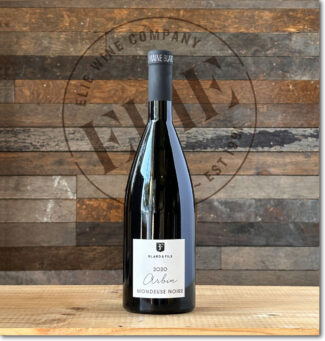 5 Blard & Fils, 2020 Vin de Savoie Arbin ‘Mondeuse Noire’ ($34) RED
5 Blard & Fils, 2020 Vin de Savoie Arbin ‘Mondeuse Noire’ ($34) RED
The Blard winery is actually in the Apremont region of France but they are leasing some 50-year-old Mondeuse vines in Arbin. Grown in clay and limestone soils, there is a pronounced iron-rich mineral note to the nose, along with red fruit and a little green apple carrying through. Somewhat lacy on the palate but with grip.
Pinot Noir: Burgundy’s Standby Finds a Mountain Home
Though it makes up less than 7% of total Bugey plantings, Bugey is still the spiritual home for Burgundy’s red wine standby, and is the only legally allowable grape in red Bugey Cru Manicle. Manicle whites, like Burgundy, are made from Chardonnay. Manicle’s zone covers a small, south facing mountain slope on the southern apex of the Jura mountain range—a unique aspect that means it can be seen for miles to the south. The calcareous slopes of these southern extremities of the Jura Mountains offer an excellent environment for grape growing. This combines with the sunny aspect and good natural drainage of the landscape. The steep slopes of the Manicle Cru vineyards optimize sunshine exposure during the growing season. High altitude Pinot Noir sports fresh red fruit and seductive tannins; featured flavors are rose, raspberry, sour cherry, anise and paprika.
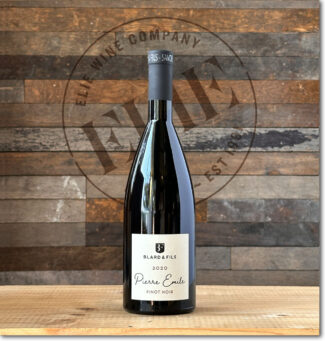 6 Blard & Fils ‘Pierre Emile’, 2020 Vin de Savoie ‘Pinot Noir’ ($32) RED
6 Blard & Fils ‘Pierre Emile’, 2020 Vin de Savoie ‘Pinot Noir’ ($32) RED
Considered by critics to be among the best examples of this varietal in Savoie, the wine shows gaminess behind its elegant cranberry mantle with hints of iron, forest floor, cassis, wild strawberry and violet. The acidity remains at the forefront and will be tamed with a bit more bottle time; the tans are elegant, silky and integrated.
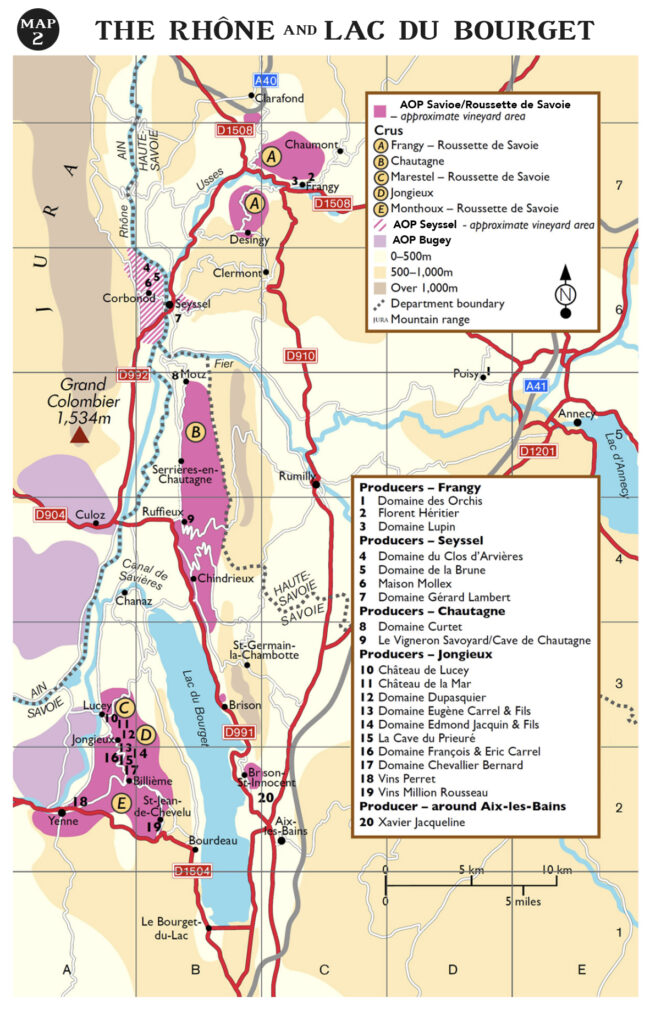
AOPs Bugey and Bugey-Cerdon: The Sparkling Lightness of Being
Bugey, with its particular focus on sparkling wine, combines all the best grape-growing elements of mountainous eastern France. It’s found close to the border with western Switzerland and the city of Geneva and covers the southern limits of the Jura mountain range; the Rhône river loops around the southern end of Bugey before flowing south to the famous vineyards of the Rhône.
The majority of Bugey vineyards surround the town of Belley with another cluster farther north, somewhat contiguous with the vineyard area of the sparkling Bugey-Cerdon. While not technically connected under French wine law, Bugey is often grouped together with Savoie due to the both geographical proximity and the wine styles produced. As in Savoie, the best Bugey sites are on the south-facing slopes where the combination of cool subalpine air, sunshine and free draining limestone soils provides the best chance for the grapes to achieve optimal ripeness.
Chardonnay is the principal grape found in Bugey and must make up at least 70% of Bugey still white wines. Smaller portions of Aligoté, Altesse, Pinot Gris and Jacquère are permitted in the blend, and the sparkling wines may have larger portions of Jacquère and Mondeuse Blanche, known as Molette. Bugey reds are made from Gamay, Pinot Noir and Savoie’s characteristic Mondeuse. Rosé wine is usually made from Gamay and/or Pinot Noir.
Sparkling white Bugey is made mainly from Chardonnay, Jacquère and/or Molette, while the reds and rosés are principally Gamay and/or Pinot Noir.
Domaine Renardat-Fâche
Bugey-Cerdon
Like many of the best estates in France, Domaine Renardat-Fâche is a multi-generational concern that traces its roots back to the Second World War, Léon Renardat and his wife Cécile, with the help of a local winegrowers, began to produce Cerdon sparkling wine using the ancestral method—a technique that avoids added yeasts or sugars. In 1974, the couple’s son Alain returned to the estate after his studies in Beaune. In 1996 , Elie, Alain’s eldest son, joined his father in the company and continued to develop the family business. This included obtaining an Ecocert FR-BIO-01 organic farming certification in 2012.
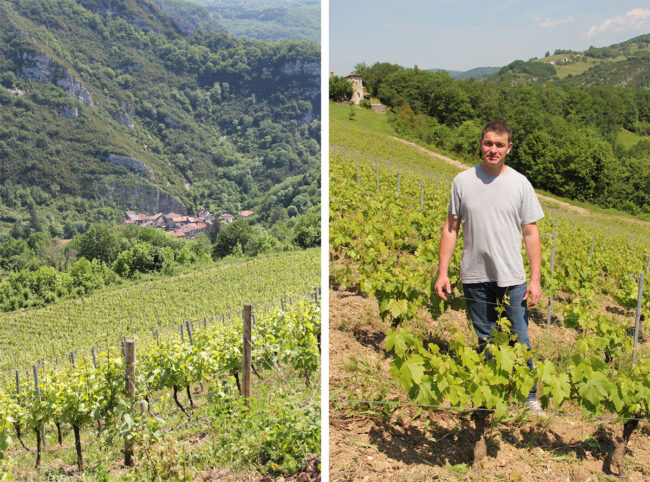
Elie Renardat, Domaine Renardat-Fâche (Courtesy of Privacy Glass)
Located around the village of Mérignat in the foothills of the Jura massif between Lyon and Geneva, the vines are grown on clay/limestone soils, some of them dating back three of the family’s nine generations.
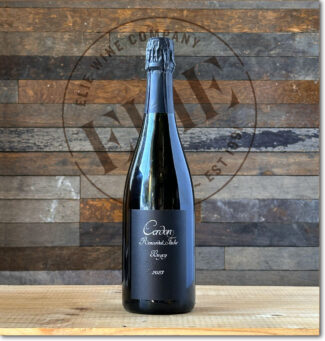 7 Domaine Renardat-Fâche, 2023 Bugey Cerdon ($28) SPARKLING ROSÉ
7 Domaine Renardat-Fâche, 2023 Bugey Cerdon ($28) SPARKLING ROSÉ
79% Gamay and 21% Poulsard from 32 organically-grown acres in high, rolling, wooded and steep hills of rocky clay-limestone soils. The fruit is harvested by hand, then gently pressed and naturally fermented at very cold temperatures in steel tanks. As is the standard in the ancestral method, the wine is bottled while fermentation is ongoing, producing the effervescence. 8% alcohol by volume.
Setting the IGP (Country Wine) Stage: Vin des Allobroges
IGP (Indication Géographique Protégée) is the European Union-wide name the category once called Vin de Pays, the ‘country wines’ of old. Certain wines from parts of the Savoie and Haute-Savoie region are not entitled to be labeled under the AOP name even if they hail from the same boundaries as Vin de Savoie, Roussette de Savoie or Seyssel. This category focuses on geographical origin rather than style and tradition, and gives winemakers greater stylistic freedom than AOP rules.
Domaine des Ardoisières
The Valley of Tarentaise
Tarentaise vineyards pride themselves as being the first ones in France (if you’re coming from Italy); they sit slightly north of the 45th parallel and occupy the south-facing slopes of the Tarentaise Valley, where soils are composed of schist and ardoise. The area is on the comeback trail, reflecting a self-sufficient agricultural society that started to decline around 60 years ago, leaving behind much fallow land. From the 5000 or so vineyard acres that dotted the area during the first half of the 20th century, not many remain today, and those that do are maintained by a small number of diehard wine growers.
In 2005, Brice Ormont left the rolling hills of his native Champagne to make wine in the shadow of Mont Blanc. Domaine des Ardoisières was created in 1998 by the iconic grower Michel Grisard; Brice Ormont took over upon Grisard’s retirement. The vineyard was planted on slopes up to 60% in grade with local grape varieties like Jacquère, Mondeuse, Altesse, and Persan. So steep is the region that Ormont claims that it receives two hours less sunlight per day; an hour in the morning and another in the evening.
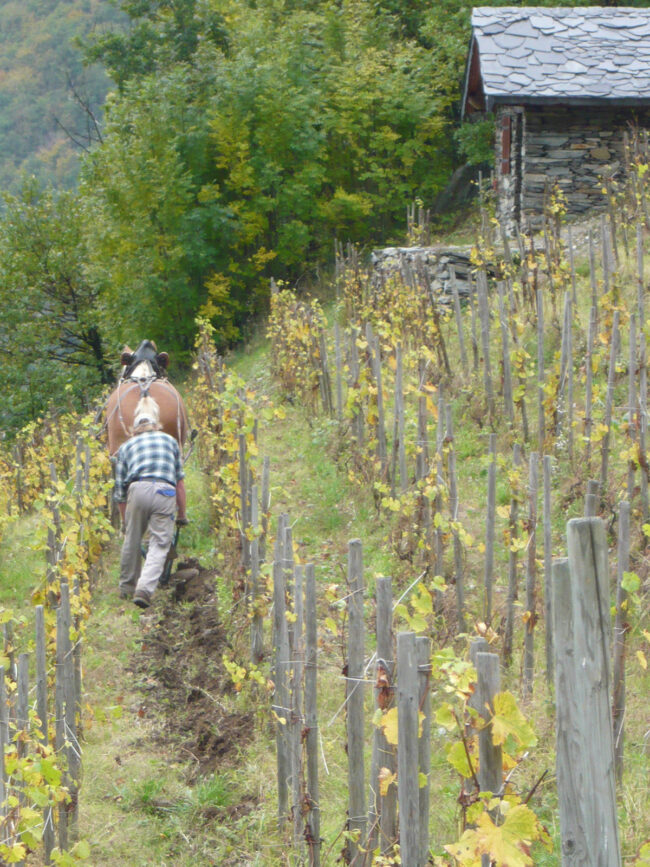
Brice Omont, Domaine des Ardoisières
“You’d think that ripening grapes would be a problem but this is not the case,” Ormont insists. “Seven of our acres face the rising sun in the east and seven more face the setting sun in the west, with the east-facing vineyards reaching incredibly high temperatures of up to 120°F during the day when the sun bounces off the schist rock and magnifies the temperature. During summer the working day stops at 1 p.m. as working these south-facing slopes in the afternoon is physically impossible.”
Gamay Noir à Jus Blanc: Mellifluous When Young, Profoundly Delicious with Age
Gamay is grown throughout Savoie and Bugey—it is the most widely planted red variety in the region, covering about 14% of the AOP vineyards. As an early budding grape, it presents yearly challenges to an alpine climate, however, and the success of the harvest in any given season depends not only on the weather, but on the age of the vines and the skill of the producer. It is a favored red in Chautagne, in whose terroir it expresses a profile of cinnamon, spices, raspberry, strawberry and pepper.
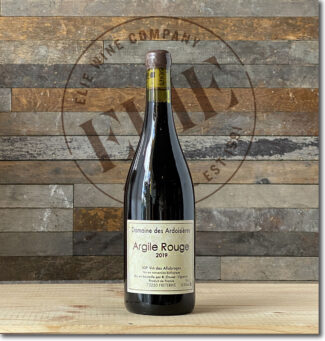 Domaine des Ardoisières ‘Argile’, 2019 IGP Vin des Allobroges ‘St-Pierre de Soucy’ ($45) RED
Domaine des Ardoisières ‘Argile’, 2019 IGP Vin des Allobroges ‘St-Pierre de Soucy’ ($45) RED
A blend of 80% Gamay and 20% Persan from 40-year-old vines grown on slate in Saint-Pierre-de-Soucy, ‘Argile Rouge’ is the rare wine that manages to present both delicacy and saturation at the same time. The nose is slightly smoky, with a touch of white pepper and red bramble; the fruit notes become more pronounced on the palate, which is bright with red currant and pomegranate. The true minerality of the mountain terroir shows up at the finish.
Persan: The Renaissance It Deserves
Persan is the poster-child grape for a wonderful variety that fell out of favor with growers, due in part to its susceptibility to fungal disease in damp weather. Among those in the know, who are willing to work with this fault, it is highly prized. Persan seems to have originated in the Maurienne Valley and was presumed extinct until it was rediscovered being grown by some local Savoie viticulturists who use it primarily as a blending grape. Alone, it produces age-worthy reds with a strong aromatic profile and in assemblages, this is what it brings to the table..
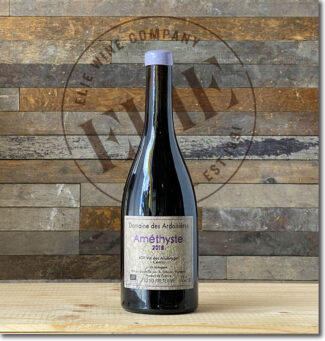 Domaine des Ardoisières ‘Améthyste’, 2018 IGP Vin des Allobroges ‘Cevins’ ($99) RED
Domaine des Ardoisières ‘Améthyste’, 2018 IGP Vin des Allobroges ‘Cevins’ ($99) RED
Biodynamically-grown Persan (60%) and Mondeuse Noire (40%) from the steep monopole Cevins with full southern exposure and a terroir of schist and mica. Yields are restricted to an average of only 20hl/ha, following which the grapes were whole-bunch fermented on native yeasts before spending 18 months in neutral oak. The flavor profile may be likened to a Côte-Rôtie with some of heavy notes replaced by the airy freshness of mountain wine; stone, raspberry and a touch of pepper to balance the bright salinity of the finish.
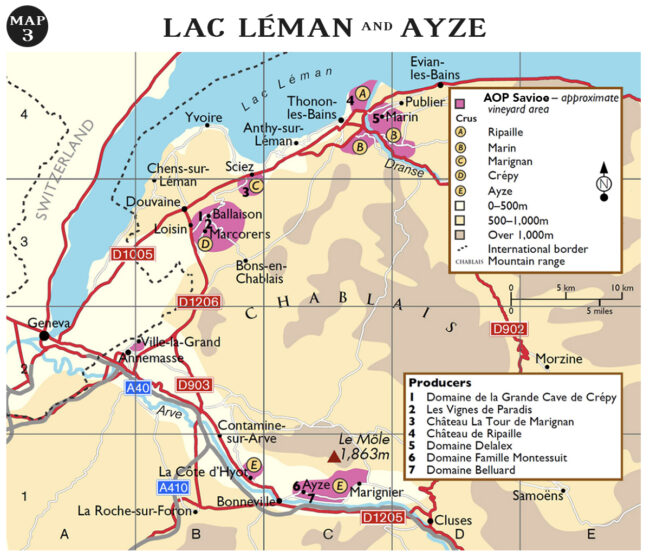
Notebook …
Climate Change: Peril and Possibility
“There is nothing constant but change.” Heraclitus, 500 BCE
It’s not likely that the Greek philosopher had Savoie wine industry in mind when he made his prophetic statement, but even in his time, viticulture depended almost entirely on the weather. And even then (and in every vintage since), the climate has been subject to gradual shifts, some more dramatic than others. Thomas Jefferson, who lived during the Mini-Ice Age of the eighteenth century was unable to grow vinifera grapes in his famed Monticello vineyards. Today, they thrive there.
In Savoie, where the threat of freezing temperatures early in the season and harsh storms in the fall haunts every vintage, there are some obvious upsides to warmer springs, hotter, drier summers and more temperate falls across the region.
But it’s a double-edged sword, since along with the extra balm comes unpredictable hailstorms, and although spring frosts may lessen on the whole, those that do hit seem to redouble in intensity. It doesn’t take more than a couple of these before a vineyard cannot recover. This doesn’t even touch on the potential threat to the ski industry, one of Savoie’s biggest draws and a steady source for wine customers.
Winemakers in Savoie feel somewhat helpless in the face of the climate—a plight of the profession since the days of Heraclitus. Innovation, which has saved the day throughout history, will find a way. In Savoie, a new generation is focused on sustainability and it is a start, but the hard truth is that marginal appellations Like Savoie are having to adapt and modify systems and farming practices that have been in place for centuries.
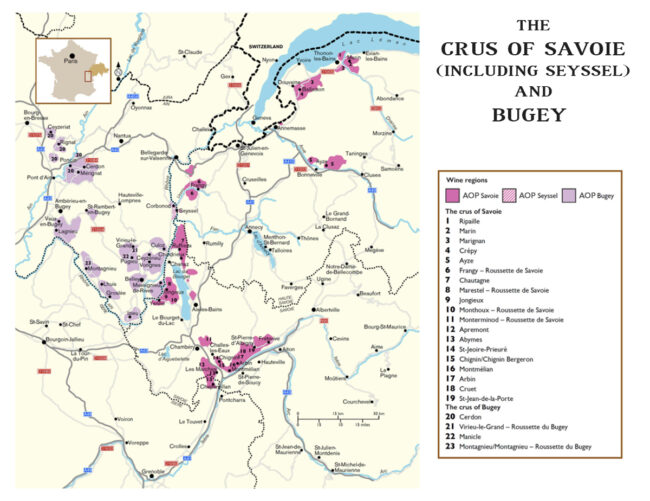
- - -
Posted on 2025.09.12 in Savoie, Arbois, France, Wine-Aid Packages | Read more...
Qué Será, Syrah: How One Grape Speaks the Vernacular of Five Northern Rhône Appellations, Through Ten Producers.
The triumvirate of Côte-Rôtie, Cornas and Hermitage rule the narrow terraces of Northern Rhône indomitably and are responsible for the world’s best Syrahs. They’ve been called ‘unicorn wines’ in that the best of them are rare, and if available, very expensive.
Throw the slightly more affordable Saint-Joseph and Crozes-Hermiatge into the fray, and you have a quintet of Syrah superlatives—the global benchmark for this richly expressive varietal on which the fortunes of Northern Rhône have been made … and lost.
Northern Rhône: Etched into the Mountain
The vineyards of Northern Rhône may be the oldest in France, but one thing is certain: Harvesting them ages the workforce. The terraced hillside sites are so steep that the grapes sometimes have to be lowered by pulley, like on a ski slope. It’s said that, in order to make a commercially viable product on sites with sufficient sunlight to fully ripen grapes, you have either to inherit an established right-bank vineyard or produce a wine so good that you can charge an exorbitant price.
Indeed, the most famous producers of the Northern Rhône are family enterprises; these are wineries that vinify grapes they grow, but also purchase fruit from vineyards along length of the entire Rhône valley. The smallholders are the ones who put the sweat equity into these demanding sites, and traditionally, only a handful of them have bottled under their own labels.
This is beginning to change as ambitious newcomers have entered the foray as grower/producers and, at least among those who have been up to the test, have improved the overall quality of the appellation.

Northern Rhône Wines: Syrah’s Reign Over the Unyielding Slopes
In the Rhône, Syrah is such an aristocratic grape that it has its own disease: ‘Syrah Decline’ reared its ugly head in 1993, and causes vines to wither and sometimes die; its cause remains unknown.
On a more salubrious note—and equally interesting—much of the top Rhône wines you may consider 100% Syrah are actually made from a clone called Sérine, most being massale-selections from field cuttings. Sérine is not identical to Syrah, in the field or on the palate; it’s more than likely a mutated and evolved version that seems restricted to Northern Rhône. It is also more savory than many contemporary Syrahs, and it is this quality which has induced winemakers to highlight this quality above all. Côte-Rôtie has traditionally blended a portion of Viognier into their Syrah-based reds to impart floral overtones that may not match this popular swing toward meatier Northern Rhônes.

A Land of Extremes: Climate Change Reshapes Syrah’s Harvests in France’s Steepest Vineyards
The terraced vineyards on the cliffs overlooking the Rhône River have always challenged wine growers on multiple fronts. The free-draining soils makes adequate rainfall a must and the Mistral winds exacerbate drought during dry spells by stripping moisture from the vines, forcing growers to plant cover crops to retain soil moisture; others experiment with mulching or adjusting canopy height to shield grapes from sunburn.
Add to that the issue of ripening Syrah at high altitudes: In years without adequate sunshine, grapes failed to reach phenolic ripeness by harvest times that are inherently limited by mountainous weather conditions. As a result, during off years, the wines of Northern Rhône tend to be vegetal, with distinct hard edges.

Enter climate change, bringing with it both heightened aggravations and surprising consolations. Over the past 40 years, average temperatures have risen by more than 2°C in the region—so much that Syrah now generally ripens without fail. Harvests must be timed carefully to avoid overripe grapes, which produce flabby wines without Northern Rhône’s customary taut acidity and pepper edge.
Another consequence of climate change is the improvement it has brought to white wines. Marsanne, Roussanne and Viognier welcome extra warmth, become riper earlier, before their critical acids begins to dissipate. Hermitage Blanc in particular, once heavy in cool years, now shows electric tension alongside richness, while Condrieu, which once had a tendency to get too ripe, is forcing growers to pull forward harvests earlier.
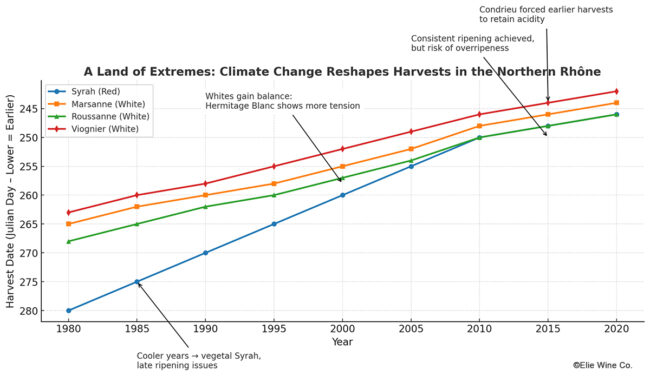
Northern Rhône Lieux-dits: Terroir Distilled to Its Smallest Scale
Lieux-dits are a wine lover’s Google Earth; a satellite view of an appellation focused on a tiny, representative parcel. Not all vineyards have lieux-dits, and among those that do, not all are created equal. In general, it’s a term that refers to a geologically homogenous portion of a vineyard with a self-contained story to tell about its quality or, occasionally, its significance to history. Although lieux-dits are generally not required to be formally registered, they are always named, and that name may occasionally be confused with a producer’s cuvée name, which is often similar. Different appellations have different laws regarding lieux-dits; in Alsace, for example, they are mandatory for Grand Cru AOP labels, whereas in Burgundy, Grand Crus are forbidden from using them.
In the Rhône, lieux-dits are often associated with the region’s top estates, and those that do not have an officially registered place in the French Cadastre are considered ‘les marques’ of their producers. In either case, they are ‘terroir distilled’—an extremely fine-tuned expression of an individual location. To recognize one is to recognize that within the sprawling Rhône there exists an almost microscopic essence that only a lieu-dit can reveal.
Hermitage: Syrah in Its Grandest
Hermitage, one of France’s most reliable appellations, is a pipsqueak that carries a big stick—both its reds and white wines are long-lived and full-bodied. The 345 acres of vineyards entitled to wear the name ‘Hermitage’ are located on a granite hillside facing south and overlooking a short section where the river Rhône flows west to east rather than north to south.
This orientation means that the grapes benefit from the maximum amount of sunlight throughout the day.
Due to slope erosion, Hermitage topsoil is relatively thin compared to that on the valley floor. However light, there are a wide variety of soil types, ranging from sandy gravel in the west, to rockier areas higher up and limestone in the center. As intense Rhône sunshine warms the hillside during the day, the granite bedrock stores this heat, encouraging the grapes to ripen more fully than those in less-exposed sites.
The effect of the local terroir is most pronounced on the western side of the hill where it is steeper than the east and enjoys prolonged exposure to afternoon sunshine.
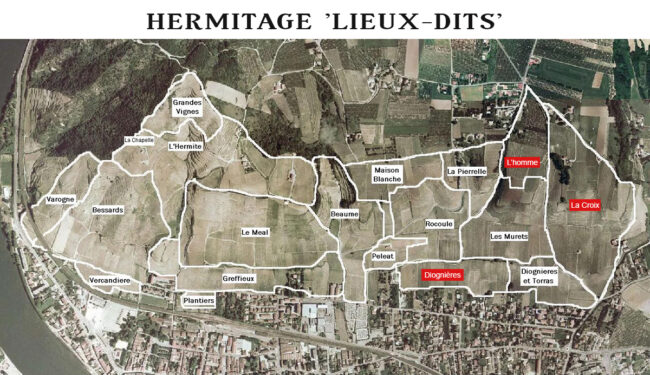
Jean-François Jacouton
The Hand of the Revivalist
Many vignerons tout their studies abroad, but Jean-François Jacouton is proud to champion his apprenticeship at Domaine Courbis at the southern tip of Saint-Joseph.
“Still,” he maintains, “It was my experiences in Savoie that taught me the value of brining mineral freshness to the wine.”
In 2003, Jacouton took over his grandfather’s acres in a few miles north of Tournon, a city that backs into the hills surrounding the Rhône Valley. In 2010, he began domain bottling. His Saint Joseph holdings include older vines in lieux-dits Les Goutelles, Verset Est Paradis, and Tinal, responsible for the stunningly rich Saint Joseph Rouge labeled Pierres d’Iserand.

Jean-François Jacouton
Dedicated to lutte raisonnée farming using horses and hand plowing, Jean-François spends spending almost all of his time among the vines.
“We are in process of reconstructing old stone terraces in areas that returned to forest following phylloxera,” he says. “This commitment to the land is the hallmark of my approach. I strive for classic, old-school reds, but emphasize cleanliness and precision. This is achieved through careful selection in the vineyards, and in the cellar, vinification and aging are in cement, amphora, demi-muids, and larger foudres fermented parcel by parcel and by using an overage of only 20% new wood.”
 Jean-François Jacouton, 2021 Hermitage ($82)
Jean-François Jacouton, 2021 Hermitage ($82)
100% Syrah grown on limestone sand and clay from older vines in the lieux-dits Diognières, L’homme and La Croix. The harvest is entirely destemmed with pigéage and pump-overs for 27 days followed by aging in French oak barrels for 14 months. The wine shows classic aromas of graphite, bacon fat, roasted spice and blackberry, all wrapped in a brilliant minerality.
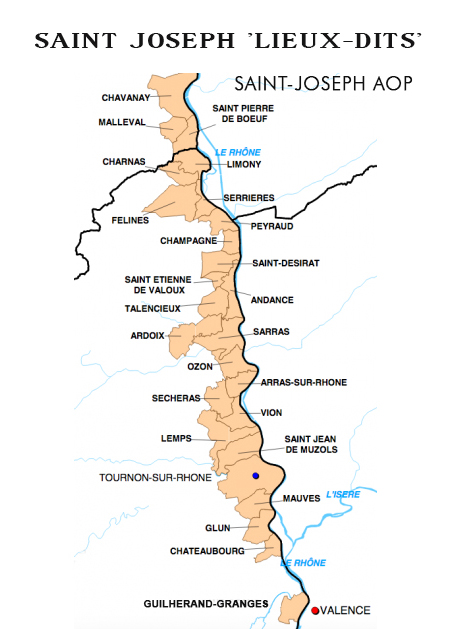
Saint-Joseph: Syrah Finds Its Middle Voice
Unlike Hermitage, St-Joseph covers a lot of territory and multiple terroirs; it encompasses 26 communes and stretches from Chavanay in the north to Chateaubourg in the south, roughly 30 miles in length. The reds from the region can be light for Rhônes, a result of soils containing less granite and vines that face east rather than south. But in strong vintages, they are spectacular.
80% of the wines made in Saint-Joseph are Syrah; only a minuscule quantity—a tenth of one percent—contain any other red wine grape. White wines makes up two in ten bottles of Saint-Joseph’s production and are based on Marsanne and Roussanne, blended or as stand-alones. These wines are dry, with honeyed, floral aromas and balanced weight and acidity, in marked contrast to the sweet Muscat de Beaumes-de-Venise wines from the southern Rhône and the heavier Viognier-based wines of Condrieu and Chateau-Grillet.
 Jean-François Jacouton ‘Pierres d’Iserand’, 2020 Saint-Joseph ($35)
Jean-François Jacouton ‘Pierres d’Iserand’, 2020 Saint-Joseph ($35)
100% Syrah from old vines in the lieux-dits Les Goutelles (at a thousand feet elevation), Verset Est Paradis (at 600 feet), and Tinal (at 1200 feet). The grapes are 30-40% whole-cluster fermented with pigéage for 24 days and aged in demi-muids for 15 months. The wine offers a nice balance of fruit and spice, with plum notes alongside dried thyme and wild raspberry; on the mid-palate, you’ll taste smoked meat and olive tapenade, all complemented by refreshing acidity.
 Jean-François Jacouton ‘Chemin de Sainte-Épine’, 2019 Saint-Joseph ($46)
Jean-François Jacouton ‘Chemin de Sainte-Épine’, 2019 Saint-Joseph ($46)
100% Syrah from old vines in the historic lieu-dit of Sainte-Épine, perched above the village of Saint-Jean-de-Muzols. Vinification is 30% whole clusters for 24 days, with pigéage and rémontage, followed by aging in new and used oak barrel 16 months. Structured and taut, the wine is loaded with concentrated flavors of wild berries and plum compote with subtle toasted notes and silky tannins.
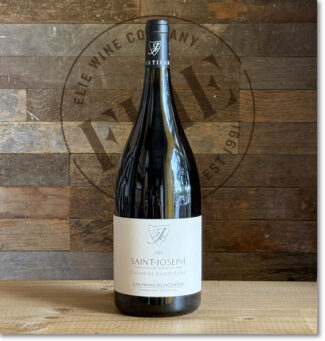 Jean-François Jacouton ‘Chemin de Sainte-Épine’, 2019 Saint-Joseph ($99) 1.5 Liter
Jean-François Jacouton ‘Chemin de Sainte-Épine’, 2019 Saint-Joseph ($99) 1.5 Liter
The larger format of this wine from 2019 is ideal for cellar storage, which slows and mellow the aging process, likely for many years.
Domaine Jolivet
The Saint-Joseph Upstart
‘St. Joe’—with its rolling granite hills on the west side of the Rhône River—is an amazing discovery. It offers the best of Rhône hillside fruit, vinified by masters of the vine working outside the pressure of the spotlight, for a fraction of the price of the more famous estates in Côte-Rôtie and Hermitage.
Among the young vignerons who are making a vinous mark in the region is Bastien Jolivet, who tends working his family’s vineyards in the hamlet of Saint-Jean-de-Muzols, just north of the birthplace of the appellation in Mauves. When Bastian returned from various internships locally and abroad (Domaine du Monteillet in Condrieu and further afield in New Zealand and South Africa), he convinced his parents to stop selling the fruit from their 26-acre vineyard to the local cooperative and bottle their own wine. This was 2014; since then, Domaine Jolivet in general—and Bastien in particular—have hauled in considerable praise, culminating in Paris with the award Grand Prix Discovery of the Year 2020 by La Revue du Vin de France for best new winemaker.

Bastien Jolivet, Domaine Jolivet
As always, the land represents the soul of the passion. Bastien says, “My goal is to work towards a complete organic certification, and in the meantime, most of our field work is handled organically. The steepest grades, of course, are the hardest to assure pure organic cultivation. All of our little plots run up the hill of Saint-Jean-de-Muzols, which often makes hand-picking a necessity. In the cellar, all fermentations are done spontaneously and aging is done in combination of 228-liter barrels and 600-liter demi-muids, nearly all used. The assemblage is done just before bottling with some time for the wines to knit together. The wines are not fined and only filtered minimally with SO2 kept to a minimum.”
 2018 Domaine Jolivet ‘Cuvée 1907’, 2018 Saint-Joseph ($70)
2018 Domaine Jolivet ‘Cuvée 1907’, 2018 Saint-Joseph ($70)
Named after the year in which the vines were planted, it is unlikely that you can find a more intense wine from any Rhône vineyard as old and at such a reasonable price: This is required sipping for anyone curious as to the sort of wine super-old Syrah can produce. The grapes are 100% whole-cluster fermented in stainless steel, then aged in ten-year-old demi-muids to best reflect the concentration of the fruit. It shows dark bramble berries, white pepper and blood orange zest.
Matthieu Barret
(Domaine du Coulet)
The Playful Radical
Matthieu Barret had an interesting plan when he took over Domaine du Coulet: To create a playful range of wines using serious technique. The success of the adventure can be gauged by how coveted his wines are, considered among the most accessible natural wines in France.
A 7th generation vigneron, Matthieu farms the vineyards that grandfather planted after WWII, intending to sell to some of the best-known producers in the Northern Rhône, including Chapoutier and Delas. In 1998, at the age of 23, Matthieu took over the family’s 25 acre vineyard in Cornas.

Matthieu Barret, Domaine du Coulet
Of his philosophy, he says, “I have always believed that the vine is happier in a wild environment. So, we have created ‘green spaces’ around the farm, digging watering holes to nourish a diverse ecosystem of vines, forest, meadow, and woodland. To further this way of thinking, I no longer use machines, replacing them with mules, horses and manual labor. Also, in a pursuit of purity and expression, I radically changed the customary vinification process by utilizing concrete eggs rather than oak.”
Currently, Matthieu creates an array of wines from leased organic and biodynamic vineyards throughout Rhône, and through trial and error, found the formula to express the unique nuances of each micro-terroir. He believes that his portfolio not only expresses the spirit of the land, but his own.
 Matthieu Barret (Domaine du Coulet) ‘D86’, 2020 Saint-Joseph ‘natural’ ($48)
Matthieu Barret (Domaine du Coulet) ‘D86’, 2020 Saint-Joseph ‘natural’ ($48)
A punchy and classically-lined Saint-Joseph, farmed biodynamically and vinified with whole-cluster fermentation and aging in a mix of 10 hectoliter terracotta pots and concrete vats. The wine is bottled unfiltered, with minimal sulfur additions. It displays wild blueberry and blackcurrant notes shored with up subtle spices and a touch of licorice.

Crozes-Hermitage: Syrah in Its Most Approachable Expression
Crozes-Hermitage is the largest of the Northern Rhône appellations, but it labors in the shadow of its storied namesake Hermitage without pretentions of equality. Price reflects that, of course, and the wine itself does hold at least some measure of the magnificence found in its massively rich, long-lived neighbor. The wine-growing region has a continental climate distinct from the Southern Rhône, and its sheer size adds to the diversity of its terroir. Soils south and southwest toward Gerans largely consisting of granite and clay, while Tain-l’Hermitage is primarily made up of rocks, sand, and clay. The flatter topography in the southern Crozes-Hermitage area is primarily alluvial soil due to Rhône river deposits.
 Matthieu Barret (Domaine du Coulet) ‘Et La Banière…’ , 2021 Crozes-Hermitage ‘natural’ ($40)
Matthieu Barret (Domaine du Coulet) ‘Et La Banière…’ , 2021 Crozes-Hermitage ‘natural’ ($40)
Et La Banière originates on the well-drained clay/limestone in Les Croix. In line with his biodynamic philosophy, Matthieu Barret pampers each Syrah vines organically and carefully controls yields. Maceration and fermentation is done on indigenous yeasts with pump-overs pumping concrete vats. The wine shows dried cranberry, pie spices and melting tannins that will become more silken with age. Some tasters have suggested a slight fizz to this wine, which is likely the result of the natural process which eschews the use of sulfur.
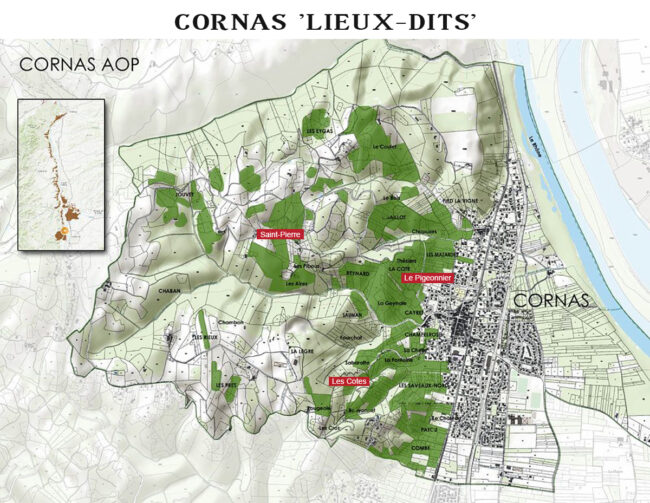
Cornas: Syrah Unbound
At just under three hundred acres, Cornas is even smaller than Hermitage; it’s smaller than some single estates in Bordeaux. It produces only red wines made exclusively from Syrah—a variety that ripens more easily here than nearly anywhere else in Northern Rhône. Celtic for ‘burnt earth,’ Cornas wines—in homage to the name or vice versa—often showcase smoky notes with deep, earthy tones. Once considered ‘country wines’ of value only to those who favor rusticity, the reputation of Cornas has surged in recent vintages, making it one of the most sought-after wines in France.
 Matthieu Barret (Domaine du Coulet) ‘Brise Cailloux’, 2020 Cornas ‘natural’ ($89)
Matthieu Barret (Domaine du Coulet) ‘Brise Cailloux’, 2020 Cornas ‘natural’ ($89)
Brise Cailloux—the ‘Broken Stone’—comes from 50 individual micro-parcels. It spends it first year 50% used oak barrel and 50% concrete eggs, then is moved to concrete eggs for the second year. The wine lusty, yet gentle, with notes that are as complimentary as they are contradictory: Blackberry, violet, lavender, raw meat and blueberry. Accessible now, but with obvious cellaring potential.
Domaine Johann Michel
A Natural-Born, Self-Taught Vigneron
Give a man a bottle and he’ll drink for a day; teach him to make wine and he’ll drink for a lifetime. Still, there is something in the spirit of the man who figures it all out for himself that excites us even more.
Johann Michel developed a passion for fine wine while tasting old vintages with his grandfather, and from there, taught himself the art of vinification. Today, with his wife Emmanuelle, he works 14 acres spread between three Rhône AOP’s. This includes a scant acre in Saint-Joseph planted entirely to Syrah, two-and-a-half acres in the extreme south of Saint-Péray planted to Marsanne and Roussanne, and his most celebrated wines made from lieux-dits in the steep, granite infused slopes of Cornas.
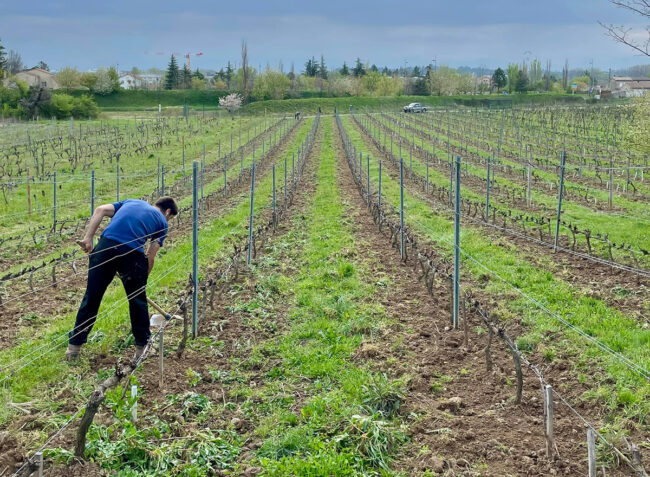
Johann Michel
Michel may be self-taught, but the effusive praise for his product is very much the domain of experts. In what may be the most hyperbolic wine review I’ve ever read, critic Jeb Dunnuck (Northern Rhône: 2019s From Bottle, February 16th 2022) wrote: “The Cornas from Johann Michel is a majestic, full-bodied, incredibly seamless beauty that does everything right, showing the ripe, sunny style of the vintage and bringing ample fruit, richness and power with incredible focus as well as purity and freshness. It will evolve for 15 years or more, and I doubt it will ever close down. Those who like flawlessly balanced Cornas should back up the truck for this sensational wine.”
 Domaine Johann Michel ‘Cuvée Mère Michel’, 2020 Cornas ‘Les Côtes’ ($149)
Domaine Johann Michel ‘Cuvée Mère Michel’, 2020 Cornas ‘Les Côtes’ ($149)
‘Mother Michel’ refers to Emmanuelle rather than Johann’s mom; we’ll leave further interpretation to Freudians. The wine was first introduced in 2016 and is not produced every year; it is Selection Massale—the replanting of new vineyards with cuttings from exceptional old vines—in this case, from the 1947 Yves Cuilleron vineyard at Chavanay. Les Côtes is a south-facing lieu-dit sits at an altitude of 900 feet and here produces an intense nose of black fruit, spices and wood smoke. On the palate, the wine is meaty and crisp with bright plum and anise, showing the sweet opulence of Syrah fruit.
Domaine Jacques Lemenicier
Thirty-Two Vintages on the Edge of Cornas
From tragedy to triumph! At the age of 18, when a vineyard-owning family member suffered a car accident, Jacques Lemenicier decided to drop out of high school and become a winemaker. Taken under the wing of Alain Voge, proprietor of the much-heralded eponymous winery in Cornas, Jacques spend ten years training under Alain, learning the vines, borrowing equipment, figuring out his own pathway. Today, he makes two wines; a Cornas from a 7-acre vineyard that perching precariously on a mountain slope and a 9 acre property that grows Marsanne and Roussanne for his steely St. Peray.

Jacques Lemenicier
With 32 vintages under his belt, Lemenicier’s experience with these rocky, challenging terrains is paying off in an accessible, affordable, and terroir-expressive collection.
 Domaine Jacques Leménicier, 2019 Cornas ($60)
Domaine Jacques Leménicier, 2019 Cornas ($60)
100% Syrah from two markedly different sites, 65% from the Le Pigeonnier vineyard just outside the village in line with the church, and 35% from Saint-Pierre, ancient Cornas vineyard that dates back to antiquity, with its first stone walls believed to be of Roman origin. The wine is lively, offering spice-tinged aromas of blackberry liqueur that pick up floral and incense nuances with air. Subtly chewy and focused on the palate with spice cake notes braced by a core of juicy acidity. Steadily building tannins resolve in a long, sappy finish.
Côte-Rôtie: Syrah’s Most Eloquent Form
Rolling above the town of Ampuis, the roasted slopes of Côte-Rôtie have several distinct personalities, one most suitable for wine, the others, less so. Only the south and south-east facing hillsides on right bank of the river are worth the discomfort of cultivating and picking, while those to the south—collectively known as the Côte Blonde—produce similar but earlier drinking wines than those produced on the Côte Brune to the north (although traditionally, the wines from these areas have been blended).
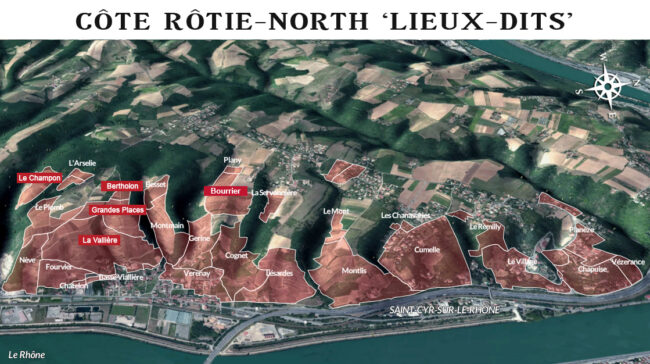

Bernard Burgaud
A Singular Côte-Rotie, Bridging Father’s Roots and Son’s Refinement
If you are going to make a single wine, might as well make it superlative. Such is the case with Bernard Burgaud, who produces about a thousand cases of Syrah per year from twenty-two acres of Côte-Rôtie vineyards, planted across several lieux-dits, the majority of which are in Les Moutonnes and Côte Blonde.
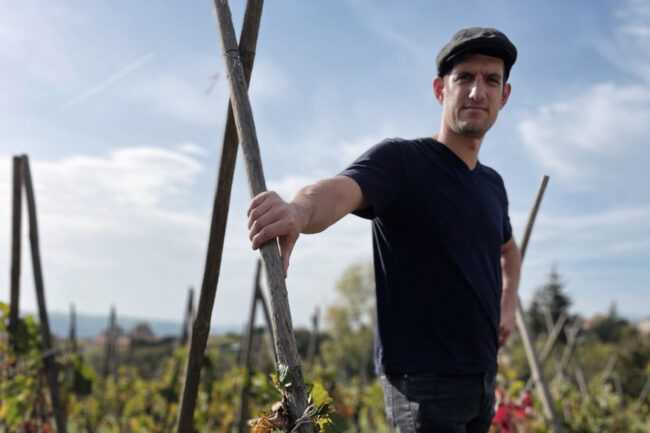
Pierre Burgaud, Bernard Burgaud
Bernard began bottling his wine in 1982. As of 2019, his son Pierre continues the family’s legacy as the winemaker for the domain. “In a nod to the estate’s blend of traditional and modern techniques, all our vineyards carry the Haute Valeur Environnementale sustainability certification,” says Pierre. “We vinify without stems, and the wines age in 20% new barriques for 15 months. Our goal is classic, well-balanced wines that taste of black fruit and olives with earthy and rustic flavors. They are meant to be aged, developing into elegant wines.”
 Bernard Burgaud, 2018 Côte-Rôtie ($72)
Bernard Burgaud, 2018 Côte-Rôtie ($72)
100% Syrah, destemmed, fermented on natural yeasts and aged for 15 months in French oak before bottling, 20% new. A strikingly herbal nose with juniper and thyme followed by clarity of fruit, with cherry, black currant and plum alongside a smoky, meaty midpalate.
Domaine Guy Bernard
Terroir and Tradition
Frederic Bernard, owner of Domaine Guy Bernard, has his fingers in a couple of very different fruit pies, one Syrah and the other Viognier. Yet he manages to combine the two (a much smaller percentage of Viognier, obviously) to create his iconic Côte-Rôtie.

Domaine Guy Bernard (Photo by Frédéric Boulant)
The estate has been in the Bernard family for years. Located in the Tupin-Semons commune, the estate produces Condrieu as well as Côte-Rôtie .
With 630 acres and 73 named parcels in the communes of Ampuis, Tupin-Semons and Saint-Cyr-Sur-Le- Rhône, Côte-Rôtie has a semi-continental climate, dry and hot in the summer, with mild autumns and harsh winters, with regular precipitation throughout the year.
 Domaine Guy Bernard, 2019 Côte-Rôtie ‘Côte Rozier’ ($65)
Domaine Guy Bernard, 2019 Côte-Rôtie ‘Côte Rozier’ ($65)
Côte Rôzier is an old lieu-dit in Ampuis planted in the 1950s by Max Pouzet. The soil is composed of micashistes. 100% Syrah, these grapes were 100% de-stemmed, fermented and macerated over three weeks and completed by daily pumping over and punching down. It matured over 22 months in 400 liter barrels of which 25% were new. The wine shows an intense nose of crushed strawberry and blackcurrant behind a spice box of anise and cinnamon, with a sweet caramel undertow.
François & Fils
An Unexpected Path to Côte-Rotie
The François family paints an interesting portrait—their main occupation is farmhouse cheese making made using milk from their herd of cows. Wine appears to have begun as an afterthought, and even today, they sell all but their finest grapes to négociants.

François & Fils
Yoann François was the main catalyst in expanding the family’s wine label; of the ten acres they own, he champions their Côte-Rôtie which is made using grapes from three south-facing parcels, ‘Les Rochains’, ‘Rozier’ and ‘Le Bourrier’, accounting in total for account for about 3.7 acres. All three lieux-dits are located in the ‘Côte Brune’ region where vineyards are very steep and soils are composed of mineral-rich mica-schist—a good base for the 30-year-old vines of Syrah and Viognier. The vines are planted at a density of 8,000 to 9,000 per hectare and yields are 35 to 40 hectoliters per hectare.
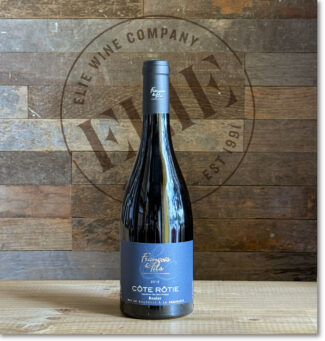 François & Fils, 2019 Côte-Rôtie ‘Rozier’ ($81)
François & Fils, 2019 Côte-Rôtie ‘Rozier’ ($81)
Rozier, in the Côte Brune, offers a perfect south-west exposition and vines around fifteen years old. The wine shows sunbaked earth and iron behind plush, plump notes of cassis balanced by a zesty spine of acidity and finishing long with hints of licorice and chocolate.
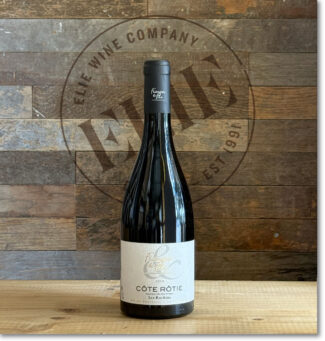 François & Fils, 2019 Côte-Rôtie ‘Les Rochins’ ($104)
François & Fils, 2019 Côte-Rôtie ‘Les Rochins’ ($104)
Les Rochins is a very steep parcel next to La Landonne and Rozier and folded into schist soils with iron and clay, producing dark, full-bodied wines that a benefit with some bottle age. This one shows ripe black cherries, incense, brambly blueberries and roasted meat along with loads of ultra-ripe tannins.
Domaine Clusel-Roch
Preserving the Rare Sérine of Côte-Rotie
Sérine—the low-yielding Syrah clone referred to as the rarest and most precious massale selection of Syrah by winemaker Stefano Amerighi—finds serene ground in Verenay, the northernmost village in Côte-Rôtie. Domaine Clusel-Roch, currently run by Gilbert Clusel, his wife Brigit Roch and (since 2009) their son Guillaume, contains nine acres of Sérine planted in 1935 by Gilbert’s grandfather; an acre of this is situated in a lieu-dit known as ‘Les Grandes-Places.’ All subsequent plantings have been massale selection from that vineyard, a rarity in the region as higher yielding material became more prevalent.
The Clusel family were also pioneers of the organic movement as they converted fully in 1990. Says, Guillaume Clusel: “The first time you set your eyes on the hills of Côte Rôtie, it is impossible not be overwhelmed with their beauty. The cliff-like granite hillsides seem to have burst from the Earth with vigor and violence. Only the truly dedicated would decide to make their living there. No tractor on earth can plow these vineyards—everything has to be painstakingly done by hand.”

Guillaume Clusel, Domaine Clusel-Roch
Today, the estate produces cuvées under the Côte-Rôtie, Condrieu, Côtes du Rhône, Coteaux du Lyonnais and Vin de France appellations and, since 2017, has had his grape distilled into marc, teaming up with his sales manager Gaëlle Bonnefond. The pair, friends since childhood, have also developed a range of beer under the name La Brasserie d’Ampuis.
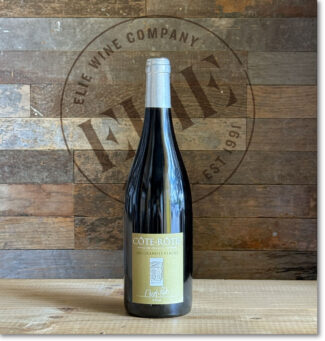 Domaine Clusel-Roch, 2014 Côte-Rôtie ‘Les Grandes Places’ ($199)
Domaine Clusel-Roch, 2014 Côte-Rôtie ‘Les Grandes Places’ ($199)
2014 was a vintage in which only top producers excelled, and only those wines from top sites. The southeast-facing hillside vineyard Les Grandes Places, with its mica-schist soils, certainly qualifies. The wine, with a decade under its belt, offers layers of jasmine, lavender, baking spices, clove, pepper, smoked meat damp tobacco notes (largely tertiary) but retains a vibrant freshness with blackberry and dark cherry at the forefront.
Christine Vernay
(Domaine Georges Vernay)
The Dame of Côte-Rotie
Few winemakers can claim to have achieved wine scores of 100 points, and even fewer can be credited with saving an appellation and a grape variety. Meet the Vernay family: Founded by Francis Vernay in 1937 in the heart of Condrieu, his efforts were crucial in establishing the official Condrieu appellation in 1940. Francis was succeeded by his son Georges, who played a key role in defining the geographical boundaries of Condrieu and is honored for saving the appellation—which grows Viognier exclusively—from extinction.
In 1996, when her brothers showed little desire to take over the family estate, Georges’ daughter Christine came on board as winemaker and General Manager of the estate and is now considered one of the great winemakers in France; several of her wines have recently been awarded the coveted 100/100 in top wine publications. Sadly, Georges Vernay passed away at the age of 92 in 2017.
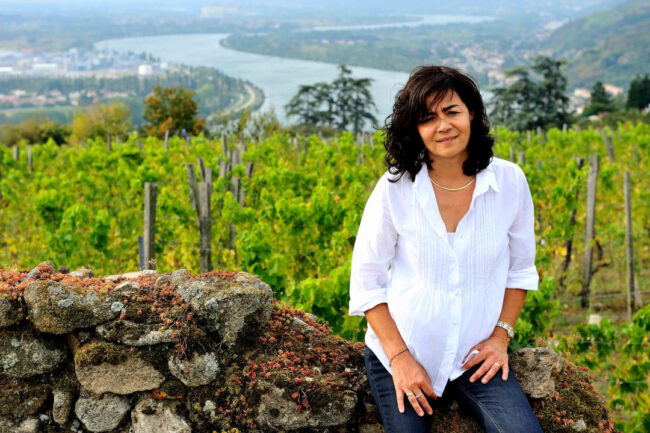
Christine Vernay, Domaine Georges Vernay
Under Christine’s direction, the fifteen-acre estate expanded their lineup by introducing a new wine from the St. Joseph appellation, La Dame Brune. Their best vines are planted on steep, hillside terroirs with granite and sandy soils. All work in the vineyards is organic and the winery was certified organic in 2019.
Christine says (with pride rather than bitterness), “Twenty years ago, it was rare for women to take over a wine estate, so I wasn’t even considered as a future manager. As the daughter of the so-called Pope of Condrieu who believed in the potential of the Viognier white grape variety from the 1970s, I only started working on this project at the age of 39. My father had saved the Condrieu appellation, pinning his hopes on the vineyard rather than cherry plantations or the cultivation of Ratte potatoes and peas, which were favored by many farmers at the time.”
 Christine Vernay (Domaine Georges Vernay, 2017 Côte-Rôtie ‘Maison Rouge’ ($208)
Christine Vernay (Domaine Georges Vernay, 2017 Côte-Rôtie ‘Maison Rouge’ ($208)
From a selection of vines planted in the 1950s; the lieu-dit is called Maison Rouge. 100% Syrah, with 30% whole-cluster fermented and matured in 20% new oak. Vibrant and exotic, with intensely perfumed blackberry and violate aromas complemented by Asian spice and smoke along with salty olive and a focused finish in which the minerality emerges.
Domaine Stéphane Ogier
Côte-Rotie, Shaped with Burgundy Precision
Rooted in Ampuis for seven generations, the Ogier family is blessed with some truly remarkable soil. Under the direction of Stéphane Ogier, the estate manages 27 acres in some of the top Côte-Rôtie terroirs—Lancement, Côte-Rozier and La Vallière. Among the ironies inherent in having seen so much change in the region is that back in the 1950s, the family’s apricots sold for more than their grapes.
In the past twenty years, the winery has grown from producing 15,000 bottles annually to more than a quarter million in 2022, and is widely regarded as a reference point for the appellation.

Stéphane Ogier
Having decided at the age of six to pursue winemaking, Stéphane Ogier first studied viticulture and oenology in Beaune and then did practical trainings with some of the best winemakers in Burgundy and abroad. During this time, he grew his philosophy of winemaking and his laser-like focus on terroir and now farms 12 individual parcels in Côte-Rôtie as well as others in Condrieu, Côtes du Rhône and Vienne.
Of particular interest is his holding in Collines Rhodanienne, of which Stéphane says: “It’s the same land as Côte Rôtie but not in the appellation. My first vintage was 1991, and the wine is made the same way as the Côte Rôties.”
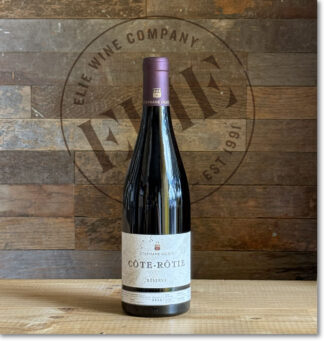 Domaine Stéphane Ogier ‘Réserve’, 2015 Côte-Rôtie ($153)
Domaine Stéphane Ogier ‘Réserve’, 2015 Côte-Rôtie ($153)
First produced in 2012, Ogier ‘Réserve’ is primarily Syrah with a touch of Viognier, and originates in 11 different lieux-dits including Bertholon, Cote Bodin, Champon, Lancement and Vialliere; it’s 65% Cote Brune and 35% Cote Blonde. The wine has matured nicely, with rich spice, licorice and sweet cherries deepening behind earth tones and tannins that have mellowed into an exotic silkiness.
 Domaine Stéphane Ogier ‘Le Belle Helene’, 2015 Côte-Rotie ($530)
Domaine Stéphane Ogier ‘Le Belle Helene’, 2015 Côte-Rotie ($530)
Power, concentration and refinement in a glass; everything about this wine is serious. It’s named for Ogier’s mother, not a lieu-dit—it comes from his Côte Rozier vineyard. Licorice, black raspberry and smoke on the nose, with cherries, rocks, stones and plums on the palate with blood and iron on the finish.

Collines Rhodaniennes IGP: A Wider Canvas for Northern Rhône Winemakers
‘IGP’ is the Europe-wide equivalent of ‘Vin de Pays’, a classification that focuses on geographical origin rather than style and tradition, giving winemakers greater stylistic freedom than ‘AOP’. Collines Rhodaniennes is in the northern Rhône Valley, and covers an area from Lyon to Montélimar and includes some of southern France’s most famous AOP appellations, including Côte Rôtie, Condrieu and Hermitage.
 Domaine Stéphane Ogier ‘La Rosine Syrah’, 2018 IGP Collines Rhodaniennes ($38)
Domaine Stéphane Ogier ‘La Rosine Syrah’, 2018 IGP Collines Rhodaniennes ($38)
An exquisitely detailed, vineyard-designated wine from a steep-pitched, granite-rich parcel two miles from the famed Côte Blonde. La Rosine is said to be Stéphane Ogier’s ‘secret weapon’ in his vineyard-specific arsenal. All the pedigree of a Northern Rhône powerhouse without the price tag; it blends scents of anise, black olives, cola and plums, revealing substantial complexity in the full, fruit-centered body.
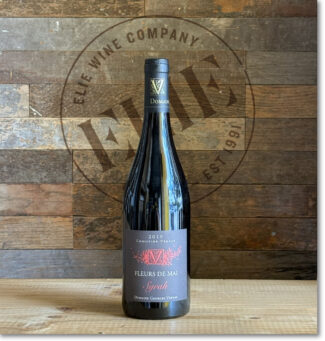 Christine Vernay (Domaine Georges Vernay) ‘Fleurs de Mai’, 2019 IGP Collines Rhodaniennes ($33)
Christine Vernay (Domaine Georges Vernay) ‘Fleurs de Mai’, 2019 IGP Collines Rhodaniennes ($33)
A classic early-drinking Syrah, not necessarily built for the long haul, but rather, to be showcased in its sensuous and silky youth. From 50-year-old vines planted adjacent to Condrieu, (hence, a IGP Collines Rhodanienne designation) fermented in stainless steel and barrel, then aged eight months in wooden vats. The wine is filled with luscious black cherries and new leather with spice and pepper in the foreground.
Notebook …
The Stalk Talk of Winemaking: To Stem or Not to Stem
When you see ‘whole cluster fermentation’ in a winemaker’s description, he or she is referring to a technique where entire grape bunches, including stems, go into the fermenter. In other words, the wine grapes do not go through a destemmer-crusher to destem individual berries and crush out the juice.
Advocates of whole cluster fermentation assert it produces wines with more complexity, and with additional herbal and spice flavors, toning down high acidity while adding tannic structure. The practice may be seen frequently with Pinot Noir in Burgundy and Oregon’s Willamette Valley, and in Northern Rhône, winemakers claim that it enhances the savory qualities and peppery notes of Syrah. Where grapes are fully ripened, as they tend to be in Cornas, stems bring significant tannin to the party, and so the wine requires intense fruit for balance. But by binding chemically with tartaric acid, stems tend to lower acidity in the process, so a careful balancing act must be maintained. It should be noted that the more mature the stems, brown and woody instead of green, the more subtle the influence.
Northern Rhône: A Vintage Chronicle
2021: Frost, Humidity and Storms Yield Elegant Wines
Like most of France in 2021, the Rhône Valley suffered from a difficult growing season. The winter and early spring was relatively dry, although temperatures were so mild that there was premature vine growth. This was followed by a series of hard frosts that dramatically cut yields, and the bunches that remained intact were subject to disease during an unusually humid summer. Cloudy skies prevented even ripening and brought devastating storms in July and August. The grapes were slow to reach phenolic ripeness and, as a result, the harvest was later, longer and slower than normal. The wines have good structure and acidity and although alcohol was lower than in other years, there was still enough to assure body. For the big red appellations like Saint-Joseph and Hermitage, black and white pepper notes come through strongly, but the wines themselves tended to be more restrained, favoring elegance over bombast. The whites are fresh, elegant and aromatic rather overblown.
2020: Drought, Heat and Early Harvest Ensures Balance
The most notable features of 2020 are beginning to sound like a ‘new normal’: Drought, heat and an early harvest. Gratefully, heavy rains in the previous October, November and December that created reserves the vines could draw from. Rain fell in May and June, although the rest of the growing season was exceptionally dry. Guillaume Sorrel (Domaine Marc Sorrel) went as far as to say that 2019 precipitation saved his 2020 vintage.
The vineyards roused early thanks to warm weather in March, but mercifully there were no spring frosts. Northern Rhône held on to this lead throughout the year, resulting in the earliest vintage since 2003. Warm days were balanced by even cooler nights, which allowed the bunches to ripen gradually and evenly, producing small, healthy and perfectly formed berries. Syrah yielded clean, fresh fruit flavors, silky tannins and refreshing acidity while Northern Rhône whites made from the typically lower acid varieties of Viognier, Marsanne and Roussanne saw enhanced perfume, vibrancy, texture and freshness.
2019: Heatwave Defines a Generous, High-Quality Vintage
2019 marked the fifth consecutive vintage in which the wines of Northern Rhône are rated very good and some, truly exceptional. It was yet another vintage marked by an intense summer heat wave, however, with hardly any other viticultural challenges to contend with most growers able to embrace yet another ‘solaire vintage’ and ushered in a sizable crop of beautifully healthy and balanced grapes.
2018: Hot, Dry Year Yields Ripe and Ageworthy Wines
2018’s ‘en primeur’ Cliff’s Notes: “Very hot and dry, resulting in a plentiful ripe crop. Many wines with low acidity and potent alcohol, but those that could achieve balance made impressive wines.”
In slightly greater detail, both the winter and spring were wet and mild but despite some light rain falling during flowering, it was still reasonably successful. Unexpected rainfall in June did cause some difficulties with mildew and rot, but it was mostly restricted to Southern Rhône. The rot meant many producers had to spray but, unfortunately, a large amount of the crop was still lost. Eventually, the damp weather dried up and a hot, dry summer took its place. By the time it came to harvest, temperatures were high and producers had to work quickly when handling the grapes.
In Northern Rhône, the harvest was shorter than in the south as the grapes ripened rapidly making excessive alcohol a potential issue. Picking began early September and lasted through to the middle of the month. Despite the hot year, the whites still retained a fresh character as well as being concentrated, while the reds ranged from black-fruit powerhouses to friendlier red-fruited wines. Although some wines did suffer a touch from too much alcohol and a lack of acidity, many were successful with interesting characters and capacity to age.
- - -
Posted on 2025.09.04 in Saint-Joseph, Cornas, Côte Rôtie, Hermitage, Brézème, Saint-Péray, France, Wine-Aid Packages, Northern Rhone | Read more...
The Color of Change: From Off-Appellation to Second-Label Standouts, Bordeaux’s Elite Producers Turn to Dry Whites – Quietly Expanding the Region’s Identity Three 3-Bottle Dry White Samplers Sauternais $88 · Médoc $234 · Pessac-Léognan $131
Location, locution, libation: The three cardinal rules of real estate are thus rewritten when Bordeaux turns from red to white, and some back-story is required for a true appreciation of the change.
And along with the climate, that story is changing almost too quickly to follow.
Twin drivers—weather and a market shift toward fresh, mineral-driven wines—happen to have aligned with Bordeaux’s efforts to reassert its white wine identity to heed the call of modern wine drinkers who seem less enamored with big, pricey, cellar-destined reds and more in fresher wines that can be enjoyed tonight. To further fuel this phenomenon, Bordeaux’s governing bodies are allowing the region more flexibility, including permitting experimentation with both heritage and non-traditional varieties. This has led some classified estates to ‘future-proof’ by increasing their plantings of white varieties, even at the expense of older, previously red-dominated vineyards.
Whereas this might seem logical in Pessac-Léognan and Graves, it’s increasingly the case in second-label and Right Bank châteaux.
This week, we peel back a multilayered curtain that formerly relegated most white Bordeaux to a postscript, and offer as packages a few examples of both first and second wines that will highlight how Sauvignon and Sémillon-driven wines from Bordeaux stand apart from those in the rest of the world.
Two thousand years of tradition and innovation have paid dividends in Bordeaux, and that sort of savoir-faire is color blind.

La Carte des Vins s’il vous plait!
Rewriting the Script: How Climate Change is Shaping Bordeaux’s White Wine Identity
Until fairly recently (with a handful of notable exceptions led by Sauternes) white wine from Bordeaux was often treated as an afterthought. Of Bordeaux’s 275,000 acres of vineyard, only about 10% are planted to white varietals, and the bulk of that winds up bottled under the often forgettable and generic ‘Bordeaux Blanc’ label.
Enter climate change, an existential threat to an industry that is thousands of years old, and as vines may thrive in poor soils, innovation often arises from a crisis.
Bordeaux’s ocean-influenced climate has warmed significantly over recent decades and its primary workhorse grapes, Cabernet Sauvignon and Merlot, in ripening earlier, have begun to develop higher sugar content (leading to more alcohol in the finished wine), sometimes at the expense of freshness and balance. Simultaneously, lighter, more lyrical wine profiles are the very qualities that modern consumers are looking for.
This alignment of stars, both in the heavens and on the shelves, works in the favor of Bordeaux’s white wine tradition, built around Sauvignon Blanc and Sémillon, with Muscadelle and Sauvignon Gris rounding out the roster—varieties that ripen earlier than the reds and offer a trend-friendly counterbalance of acidity and aromatic freshness.
Climate Change and the Future of Bordeaux Wine
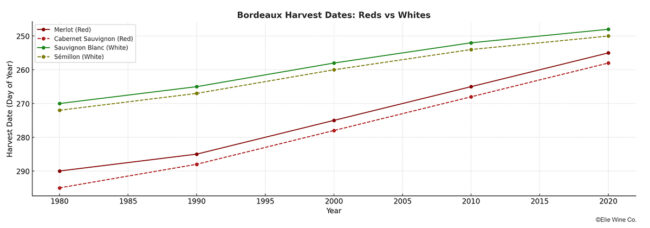


Whites from the Land of Sweets: Three-Bottle Sampler | $88

When it comes to Sauternes, the popular notion is that there is d’Yquem and then there is everyone else. This may be accurate in terms of pricing, but quality is a matter of taste. In fact, many other estates are often overlooked when consumers lock themselves into celebrity fawning, and there are several châteaux whose shift toward dry wines—survival mode though it may be—are creating outstanding products at outstanding price points.
This week’s dry white sampler package will open up the vista of Sauternes styles with which you may not be familiar, but can easily—and affordably—learn to love.
Bordeaux Blanc: The Dry Side of Sauternes
When the coffers begin to run dry, so do the wines. That could be a new motivational slogan and business model in Sauternes, home to the most celebrated sweet white wines in the world. Its reputation is built on low yields of botrytized grapes, and has always been a luxury at any table; these days, it faces a shrinking consumer demand for sweet wines (even the best) and top tier labels have seen a string of lackluster vintages—this, in a market where prime vintages such as the 100-point trio of 2001, 2007 and 2009 represented the lion’s share of sales.
Says Bérénice Lurton, who recently sold her majority stake in Château Climens; “Turning a profit from Sauternes can be an utterly demoralizing task.”
With the possible exception of Château d’Yquem, most estates cannot rely on their sweet wines to pay the bills without help, and in many cases, this involves turning toward the production of dry Sauternes.
Sauternes vintners don’t describe any specific climactic conditions preferable for parcels destined for sweet-versus-dry production, and this makes sense considering the château model, wherein estates harvest fruit from their contiguous properties rather than sourcing from multiple vineyards. As a result, all of these sites have the propensity to develop noble rot, leaving that question out of the equation when choosing dry parcels. Instead, vignerons might choose their dry wine plots based on varietal composition or vine age (typically setting aside the older vines for Sauternes). Commonly, the dry wine portions of the vineyard are decided upon before the growing season and rarely alter between vintages.
And now the irony: Although aggravated in recent years, the weather in Sauternes, as in the rest of Bordeaux, has been warming for nearly a century, today’s dessert wines were considerably drier and more suited as an accompaniment for the first course rather than the last; chefs considered Sauternes as an ideal accompaniment to salmon and turbot.
Even as late as the 1980’s, the top producers had not entirely secured their current reputation for creating France’s most iconic dessert wine. And so, the current return-to-the-future of dry wines in Sauternes, may be part of an ongoing cycle of climate adaptations and the ever-present hunt for consumer approval.
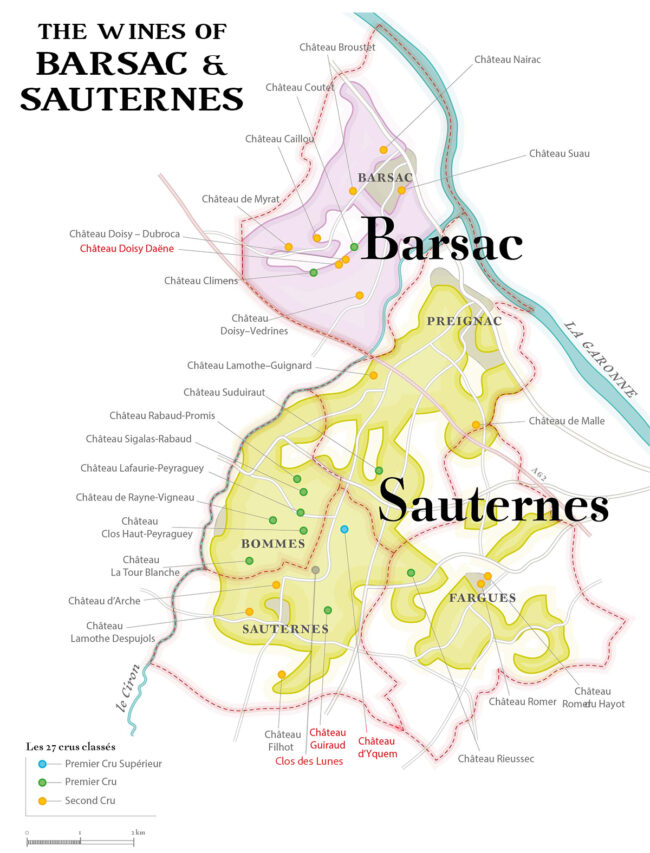
La Carte des Vins s’il vous plait!
Château Doisy-Daëne
Barsac
Château Doisy-Daëne in Barsac (one of Sauternes’ five villages) claims to be the first classified growth to produce a dry wine, beginning in 1948:
“Sweet wines were doing very well. It originally seemed a shame to produce a dry Bordeaux in a classified estate,” explains Jean-Jacques Dubourdieu, vigneron at Château Doisy-Daëne says of his great-grandfather’s decision.
Located on the clay-limestone plateau atop Haut Barsac, Doisy-Daëne has depended on this geological unicorn to create three distinct top quality wines; Château Doisy Daëne, a sweet Sauternes, L’Extravagant de Doisy Daëne, (an extra sweet Sauternes produced only in select vintages), and Grand Vin Sec du Château Doisy Daëne—a dry Bordeaux Blanc from 100% Sauvignon blanc and aged 8 months in oak barrels of which 20% new.
The estate’s 45 acres of vineyards are planted with 86% Sémillon and 14% Sauvignon blanc.
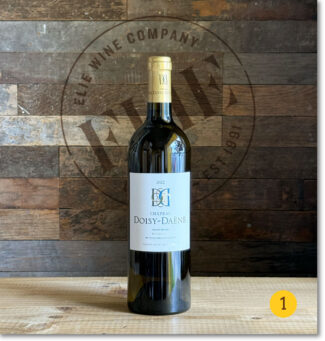 1 Château Doisy-Daëne, 2022 Bordeaux Blanc ($35)
1 Château Doisy-Daëne, 2022 Bordeaux Blanc ($35)
Succulent and fresh, Doisy-Daëne’s ultra-affordable Sauvignon Blanc is an herbal blend of verbena, thyme, tarragon and oyster around juicy core of white peach, gooseberry, lemon peel and yellow plum; gracious and light, this is an ideal seafood accompaniment.
Château Guiraud
Sauternes
Talk about specificity: Château Guiraud states its location as being ‘between the church bell and the first vines of d’Yquem.’ Chances are, those vines are Sémillon, since that great estate is predominantly planted to this variety. Robert Peugeot and three winemakers—Olivier Bernard, Stephan Von Neipperg and Xavier Planty—purchased the estate in 2003.
And what a purchase! Guiraud is massive at 250 acres. The soil is 80% gravel and 20% gravel mixed with clay, and sub-soils composed mostly of sand. Varieties are broken down to 65% Sémillon and 35% Sauvignon Blanc. Harvests, in an effort to find grapes with ideal ripeness and noble rot, are done by hand, in six individual passes.
About 17 acres are reserved for ‘Le G de Guiraud’—the dry version—in which 80% of the three-week-long fermentation takes place in barrels previously used for their Premier Cru Classé Sauternes and 20% in stainless steel vats. Following this, the wine is aged in barrels for 7 months with stirring on the lees.
Guiraud was certified organic wine in 2011, but had been practicing it since 1996—the first of the 1855 Premiers Crus to do so.
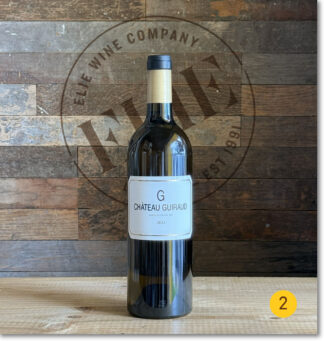 2 Château Guiraud ‘Le G de Guiraud’, 2023 Bordeaux Blanc Sec ($25)
2 Château Guiraud ‘Le G de Guiraud’, 2023 Bordeaux Blanc Sec ($25)
An even blend of Sémillon and Sauvignon Blanc, aged seven months in the oak barrels that produced the previous year’s Premier Cru, the wine is expressive and complex showing Meyer lemon, mint leaves, mandarin orange and a lot of minerality in the finish.
Clos des Lunes
Sauternes
When Olivier Bernard, (from an old Cognac-producing family) bought the Domaine de Chevalier in 1983, the estate that was ranked among the Crus Classés for both red and white wine in the Classification of Graves of 1953 and 1959. In 2011 he embarked upon a shocking project: ‘Clos des Lunes,’ in which he wanted to produce the best dry white wine in Bordeaux by taking grapes destined to craft perhaps the most desirable dessert wine in the world (Sauternes) and create instead a dry white wine which would sell for under $30.
The 110-acre estate is planted to 70% Sémillon and 30% Sauvignon Blanc. The vines are old-ish, with an average age of 30 years. Lune d’Argent is the heart of Clos des Lunes’ production, and the estate refers to this wine as the ‘La Grande Cuvée.’
All work done is organic, with the goal of moving to a complete, self-sustaining vineyard. Bernard says, “In Sauternes, respect for nature is inextricably linked with the region’s viticultural heritage. The development of botrytis can only occur in a vineyard where the environment is protected. Reconversion to organic agriculture is relatively straightforward. A traditional, natural, manual approach in the vineyard and winery has been passed on from generation to generation.”
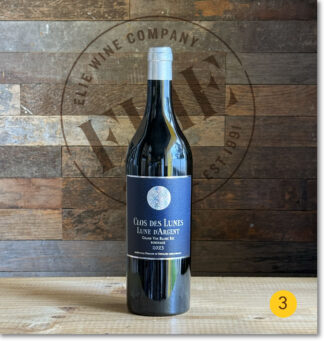 3 Clos des Lunes ‘Lune d’Argent’, 2023 Bordeaux Blanc ($28)
3 Clos des Lunes ‘Lune d’Argent’, 2023 Bordeaux Blanc ($28)
Tart and quite tropical with crushed citrus, pineapple, and white flower notes. With a touch of French oak, the Sémillon is dense and rich, the Sauvignon Blanc refined and precise. This cuvée is vinified dry, but promises to convey all the magic of Sauternes.
Château d’Yquem
Sauternes
As the only Sauternes to hold the Premier Cru Supérieur designation, d’Yquem is the undisputable top-tier of Sauternes, and so much press has it received over the centuries that it is difficult to avoid repetition. In short, Château d’Yquem is a global icon for dessert wines.
Part of that reputation is due to d’Yquem’s location; perched on a hilltop at the highest point in the appellation, its unique microclimate allows for winds from the east to move through the vineyard, helping to remove excessive moisture late in the growing season as the noble rot sets in. Botrytis, of course, is the key element in sweet Sauternes, from the lowliest to the mightiest. This fungus, given ideal conditions, shrivels grapes on the vine, concentrating their sugars and acids and creating the myriad flavors that in d’Yquem, are magnified.
Although the estate owns three hundred acres, only a portion are used in any given season. It is this somewhat obsessive-compulsive attention to detail that is the second factor that makes Château d’Yquem, even in its own appellation. Harvesting is carefully timed, and on average six passes through the vineyard are undertaken each year, where only botrytized grapes are selected. Yields are restricted to about a quarter of those allowed by AOP rules. Once pressed, the grapes are pressed again, and then a third time before being transferred to oak barrels for maturation over a period of about three years.
Château d’Yquem’s terroir is not particularly unique—a combination of clay, gravel, and sand over a bed of deep limestone soil. The clay varies, depending on the parcel. Interestingly, though, one can even find some of the same blue clay that makes up the soil in another Bordeaux superlative, Château Pétrus.
 Château d’Yquem ‘Y’, 2022 Bordeaux Blanc ($270)
Château d’Yquem ‘Y’, 2022 Bordeaux Blanc ($270)
Roughly pronounced ‘ee-grek,’ d’Yquem’s has been producing a dry white, ‘Y’, since 1959, using vines and grapes chosen prior to harvest. While one bunch of Sauvignon Blanc may be designated for ‘Y’, the remaining bunch can be used for first-label d’Yquem if the necessary amount of noble rot develops.
It is produced in limited quantities (fewer than 1000 cases), and only in select vintages.
2022 was a ‘Y’ year—a cool, dry winter preceded a sweltering summer, ensuring that the grapes reached full phenolic ripeness. The dry conditions, while not ideal for botrytis, did, manage to keep other diseases at bay. Composed of 60% Sauvignon Blanc and 40% Sémillon, the 2022 Y has 6 grams per liter of residual sugar. The dry steeliness of Sauvignon Blanc couples with the richly honeyed qualities of Sémillon, and show notes of sliced apple, pineapple and lychee.
Bordeaux Blanc: When Great Vineyards Go Off-Label
As alluded to previously, climate change has forced most wine estates in Europe into some sort of self re-evaluation. In many cases, the higher sugar content of grapes in warmer seasons equates to more alcohol in the final wine, which bucks the trend in modern consumer tastes.
“The market is moving towards more drinkable wines,” says Helen Durand, the owner of Domaine du Trapadi in the Rasteau AOP. “That translates to a preference for whites, which are often more acid-driven, lower in alcohol, and generally fresher than the international style of red wine that once reigned.”
And nowhere did that ‘international style’ reign with a stronger hand than in Bordeaux. Between 2015 to today, exports of white Bordeaux to the U.S. have grown by over one-third and almost doubled in value.
Growth could be even stronger, according to Mary Gorman-McAdams, a Master of Wine currently writing a book about white Bordeaux for the Académie du Vin’s Classic Wine Library: “There are probably about 100 producers making white wine in the region at the moment, but those are simply labeled AOC Bordeaux. Producers have really exciting whites, but their importer partners aren’t bringing them in. It’s a Catch-22—Bordeaux gets slighted for not being innovative, but then those partners refuse to take on these forward-looking white wines because ‘that’s not Bordeaux.’”
We’re hoping that these selections convince you otherwise.

La Carte des Vins s’il vous plait!
Château Lynch Bages
Pauillac
Amid the fanfare and the brilliant marketing (Jean-Michel Cazes sent a bottle of 1975 Lynch-Bages into outer space aboard the space shuttle Discovery), Fifth Growth Château Lynch Bages is worth the hype. Under the tireless campaigning and quality-improvement of the Cazes family, who have owned the property since 1934, the estate has expanded to over 250 acres to the south and southwest of Pauillac.
Improvements to both soil and technique have been a hallmark of the Cazes approach; a massive renovation and modernization of the wine cellar took place in 2017, and cutting-edge vineyard management now includes satellite imaging to survey the vineyard and conducting soil surveys to ensure the vines reach their full potential.
Part of this potential lies in white wine production, with 15 acres devoted to it. Planted to 53% Sauvignon Blanc, 32% Sémillon and 15% Muscadelle, Lynch Bages Blanc made its debut in 1990.
 1 Château Lynch Bages ‘Blanc de Lynch-Bages’, 2022 Bordeaux Blanc ($108)
1 Château Lynch Bages ‘Blanc de Lynch-Bages’, 2022 Bordeaux Blanc ($108)
67% Sauvignon Blanc, 22% Sémillon and 11% Muscadelle; the grapes undergo a mix of pressings, both with and without stems, followed by fermentation in oak for two-thirds of the crop and in vat for the rest, then aging for six months on lees. The wine’s color shows brilliant straw tones and flavors run from passion fruit to grapefruit, lemon curd and white peach with hints of honeysuckle, lime blossom and a finish of dusty chalk.
Château du Tertre
Margaux
In French, ‘tertre’ means ‘hillock,’ which is perfectly describes where the vineyards of Château du Tertre are located. With a history dating to 1143, du Tertre is one of the oldest properties on the Left Bank. At 134 acres, it is the same size today as it was at the time of the 1855 Classification of the Médoc, making it a rarity.
Tertre soil is mostly gravel with some sand pockets on two gently sloping hills where cooler ambient temperature has been credited with the wine’s much-vaunted freshness, since the cooler ambient temperature adds more zing to the wines. The single bloc is planted to 43% Cabernet Sauvignon, 33% Merlot, 19% Cabernet Franc and 5% Petit Verdot, separated from their sister property, Château Giscours, only by a small stream.
Beginning in 2014, the estate began to produce a white wine based on the peculiarity of terrain on the estate, which includes a large pine forest. Proximate to this natural feature of the landscape are varieties unusual for Margaux, including Chardonnay, Viognier and small amount of Gros Manseng.
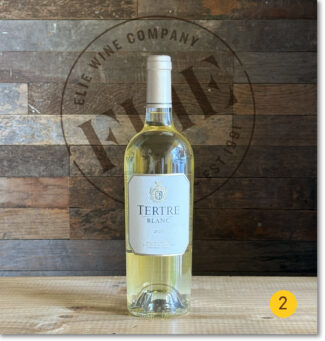 2 Château du Tertre ‘Tertre Blanc’, 2021 VDF ‘Bordeaux-Margaux’ ($39)
2 Château du Tertre ‘Tertre Blanc’, 2021 VDF ‘Bordeaux-Margaux’ ($39)
38% Gros Manseng, 25% Viognier, 25% Sauvignon Blanc and 12% Chardonnay: Succulent and full-bodied with lots of exotic fruit—guavas, green mangoes and gooseberries wrapped in subtle creaminess. Bone-dry with a quick saline tang at the end.
Château Brane Cantenac
Margaux
One of fifteen Deuxièmes Crus (Second Growths) in the original Bordeaux Wine Official Classification of 1855, the estate had been producing one of the Médoc’s most highly regarded wines long before that. For four consecutive generations, the Lurton family has been at the helm, with Henri Lurton as the current proprietor. He says, “The exceptional terroir of Château Brane-Cantenac is made of deep quaternary-era gravels. Each plot has been carefully studied to plant the most suitable grape-variety, the one which will express itself the best on it. Along with my team we strive to reveal each plot’s potential by working in a plot by plot and intra-plot approach: The ‘Burgundy way.'”
Brane-Cantenac’s terroir can be subdivided into several parcels; the first and most valued is planted in a large sweep of gravel in front of the château at the top of the Margaux-Cantenac plateau, providing radiant heat to the vines as well as excellent drainage. The second section is situated behind the château, where the gravel is intermixed with sand. La Verdotte is a 25-acre vineyard planted 35 years ago with 55% Cabernet Sauvignon, 40% Merlot, 4.5% Cabernet Franc, and 0.5% Carmenère. A fourth vineyard called Notton is a 13-hectare plot of coarse gravel over clay, and more distant from Brane-Cantenac than the other vines.
A newbie to white wine, the estate has a scant ten acres in the cooler Haut Médoc planted to 80% Sauvignon Blanc and 20% Sémillon. 2019 was the first vintage that Brane-Cantenac Blanc was produced.
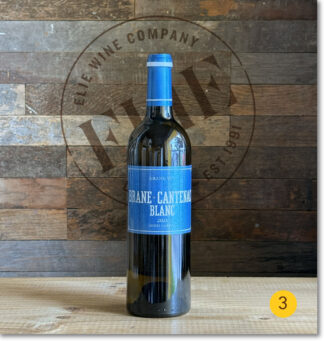 3 Château Brane Cantenac ‘Brane-Cantenac Blanc’, 2021 Bordeaux Blanc ($87)
3 Château Brane Cantenac ‘Brane-Cantenac Blanc’, 2021 Bordeaux Blanc ($87)
70% Sauvignon Blanc and 30% Sémillon; the wine offers an aromatic opening of pineapple, mango and grapefruit, which leads into a honeyed mid-palate filled with gooseberry, lime zest and a touch of fresh thyme and coriander.
Château Margaux
Margaux
Margaux has drawn praise from aficionados as diverse as Suzi Quatro (“I’m a bit of a wine snob and like a glass of Château Margaux ’82 to unwind) and Ernest Hemingway (“I drank a bottle of wine for company, Château Margaux. It was good company” – ‘The Sun Also Rises’), while Thomas Jefferson waxed philosophically about vintage 1784.
In part that is because Château Margaux is the most user-friendly of the five classified Premier Cru Classé wines: André Lurton, who grew up in a Margaux wine family in the 1930s, sums it up like this: “Wines here were never about extraction or power. They were all about finesse. That’s what we looked for and admired in a wine.”
Château Margaux covers about 650 acres, of which 210 acres are entitled to the Margaux AOP declaration. 200 acres are planted to 75% Cabernet Sauvignon, 20% Merlot, with 2% Cabernet Franc and Petit Verdot.
30 acres are dedicated to Sauvignon Blanc to make the dry white Pavillon Blanc.
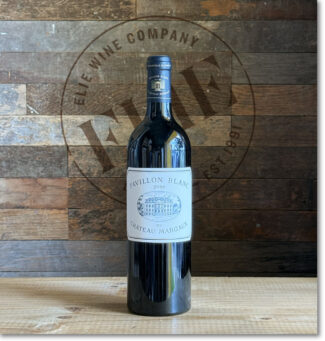 Château Margaux ‘Pavillon Blanc’, 2018 Bordeaux ($351)
Château Margaux ‘Pavillon Blanc’, 2018 Bordeaux ($351)
100% Sauvignon Blanc. Château Margaux is old hat at producing white wine; this label came into being in 1920, and was called Château Margaux Vin de Sauvignon prior to that. These days, it is produced in very limited quantities and crafted in the new ultra-modern winery designed by architect Norman Foster. The wine shows an electric blend of kiwifruit, passionfruit and mineral acidity with a long, mineral finish.
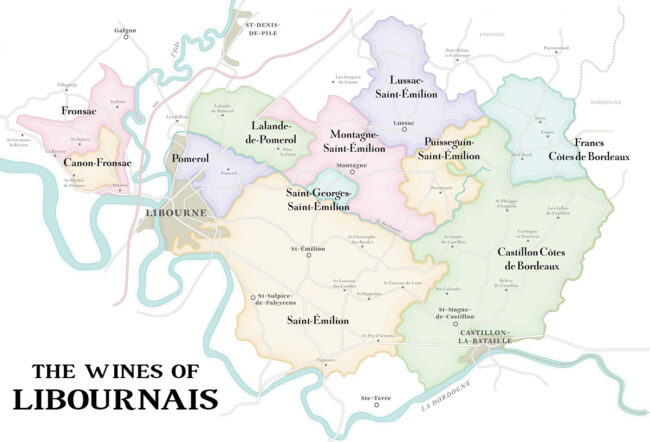
La Carte des Vins s’il vous plait!
Château Cheval Blanc
Saint-Émilion
The fact that the estate is located in the northwest portion of Saint-Émilion on the Pomerol border explains some of the renowned voluptuous quality of Cheval Blanc; it is rightly claimed that the ‘White Horse’ showcases the best attributes of both appellations.
In 2015, Cheval Blanc started producing a dry white wine called ‘Le Petit Cheval Bordeaux Blanc.’ The initial vintages were produced using 100% Sauvignon Blanc. Starting with the 2018 vintage, the wine has been made using a blend representing the vineyard makeup—80% Sauvignon Blanc and 20% Sémillon—planted on three-and-a-half acres just across the road from Cheval Blanc in vineyards previously used by La Tour du Pin.
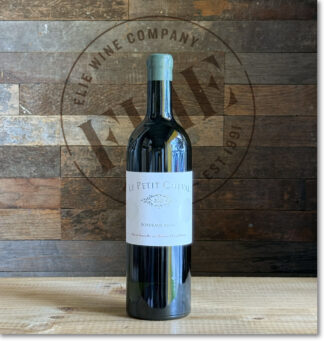 Château Cheval Blanc ‘Le Petit Cheval Blanc’, 2021 Bordeaux Blanc ($207)
Château Cheval Blanc ‘Le Petit Cheval Blanc’, 2021 Bordeaux Blanc ($207)
83% Sauvignon and 17% Sémillon. At the end of pressing, the lightly settled grape musts were fermented in demi-muids, foudres and wooden vats.
“After vinification, the rhythm of stirring, initially on a daily basis, decreases,” according to the production crew.
The wine is a finely-balanced mix of acidity and fleshiness, showing apricot and white pear nuanced with fennel.
Château Vieux Taillefer
Saint-Émilion
This postage-stamp of an estate, perched on the bank of the Dordogne river, is only 12 acres in size. It’s planted mostly to Merlot with a little Cabernet Franc and a handful of white varietals planted in the 1950s.
Philippe Cohen, originally from Paris, lived in Saint‐Émilion for 10 years working as a négociant, while his wife Catherine studied oenology. They were able to purchase Vieux Taillefer in 2006, fulfilling a lifelong dream of producing world-class Bordeaux.
And yet, the couple has approached the Château with a Burgundian sensibility. All fruit is hand-harvested and undergoes a careful sorting before it is vinified in concrete tanks. The work is 100% organic, and there is no fining or filtration, and the Cohens are quick to point out that they employ no consultants at Vieux Taillefer.
They produce a white wine from 75-year-old vines, a blend of Sauvignon Blanc, with some Semillon, Sauvignon Gris, Merlot Blanc, and Chasselas.
“More than 200 years ago, the majority of the production in Saint‐Émilion was white,” Catherine points out. “This wine pays homage to that history.”
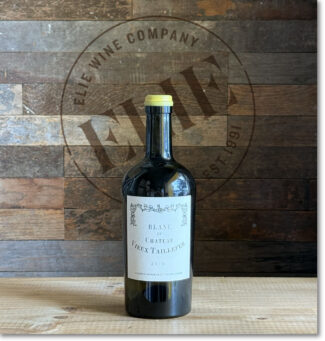 Château Vieux Taillefer ‘Blanc du Château Vieux Taillefer’, 2018 VdF ‘Bordeaux-Saint Émilion’ ($74)
Château Vieux Taillefer ‘Blanc du Château Vieux Taillefer’, 2018 VdF ‘Bordeaux-Saint Émilion’ ($74)
Says Philippe Cohen: “This wine is blend of five grape varieties, the majority of which is white Merlot, a somewhat unique grape. It comes from a plot located in Saint-Christophe des Bardes, on a limestone soil with starfish, in the heart of Saint-Émilion. These very old vines are today the only white Merlot vines existing in the era of the appellation.”
The grapes are vinified and aged in new, very lightly toasted 300-liter cigar-shaped wooden barrels from central France. It shows honey, lemon, green apple and lightly toasted almonds over a gunflint core.
Clos du Milieu
Castillon-Côtes de Bordeaux
The Clos du Milieu is an offshoot of the famed Château Angelus, formerly a Premier Grand Cru Classé A in Saint-Émilion. Made entirely from vines under the management of the mother estate, the two cuvées, one red and one white, are intended to widen the Angelus range while promoting the Castillon-Côtes de Bordeaux appellation. Both bottlings are produced at Angelus’ Chai Carillon, but in a dedicated cellar.
Clos du Milieu Rouge is sourced from a single plot of Merlot bordered by hedgerows and located a few miles from Saint-Émilion, where deep clay-limestone soils on the upper slope lend tension and density to the wine that may at times rival the vineyards of Saint-Émilion at a considerably more relaxed price-point.
Blanc du Milieu originates in a four-acre plot of Sémillon and Sauvignon Blanc grape varieties situated in the commune of Castillon-la-Bataille, where the soil is clay and the soft, porous limestone known as ‘tuffeau.’
 Clos du Milieu ‘Blanc du Milieu’, 2022 IGP Atlantique Blanc ($49)
Clos du Milieu ‘Blanc du Milieu’, 2022 IGP Atlantique Blanc ($49)
60% Sémillon and 40% Sauvignon Blanc, the grapes for this cuvée were direct-pressed and cold-settled; fermentation occurred in a combination of new barrels, stainless steel vats and concrete eggs. The aging lasts 18 months on fine lees with bâtonnage in new barrels and concrete eggs. The wine shows apricot and grapefruit on the nose, with a palate revealing subtle oak, roasted hazelnuts, stone fruit and a nettle-like herbalness.
Second Wines: Three-Bottle Sampler | $131

Rather than shedding tears, Bordeaux adds tiers—and classification is what Bordeaux is all about. While the Grand Vin is expected to be any château’s A-game, with technological advancements and an increasingly warm climate, the price of these top-shelf wines has risen with the temperature, and quality is ensured by an ever more rigorous selection of grapes on the sorting table.
Second wines—a tradition begun by Château Margaux in the 17th century—were the logical place to place grapes deemed unfit for inclusion in the Grand Vin. And since the terroir in which they were grown was often similar, and occasionally identical to the first wines (and generally made by the same vigneron), it stands to reason that the great estates would release these ‘little brother wines’ under some version of their famous name.
When an estate famed for red wines releases a white, it may not always be the result of substandard fruit—just fruit of a different color. That is certainly the case in this three-bottle sampler, where the wines have been treated with the same circumspection as the reds, and are often produced in response to consumer demands.
Pessac-Léognan Blanc: Second Acts, First Class
In 1987, a long-standing wrong was righted: The villages of Pessac and Léognan were singled out from the greater Graves region and given their own appellation. This move acknowledged that the wines of the newly-formed Pessac-Léognan were unique from surrounding villages in both depth and focus. Among the estates able to claim the new appellation title was the Premier Cru Château Haut-Brion.
Most of the area remains staunchly red—among the 4000 acres of Pessac-Léognan vineyard, more than 75% are planted to Cabernet Sauvignon and Merlot. It is the remainder that we will focus our attention upon: Unlike the famous sweet white wines from nearby Sauternes, Pessac-Léognan whites are generally crisp, dry and mineral-filled, with citrus notes, often with rich character notes added through oak aging and capable of improving for up to a decade. They are made predominantly from Sauvignon Blanc and Sémillon, a duo that thrives in the sandier soils of the appellation and results in some of the most stunning examples of this blend that can be found.
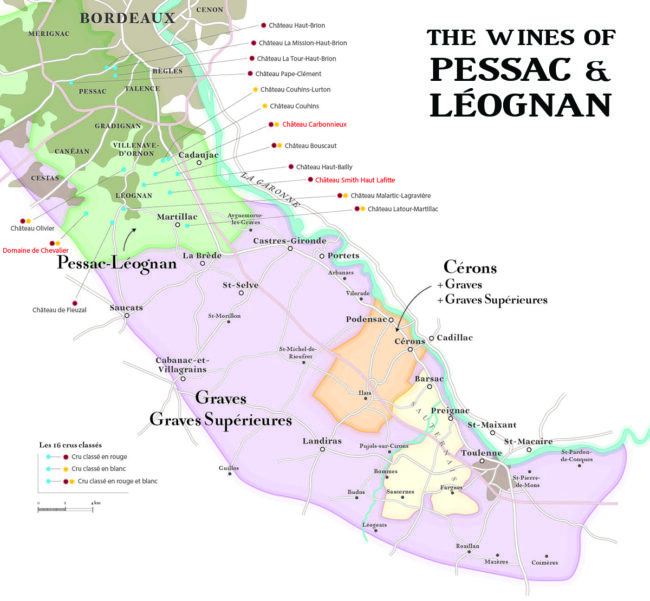
La Carte des Vins s’il vous plait!
Château Smith Haut Lafitte
Pessac-Léognan
Rated as a red wine ‘Grand Cru Classé’ in the 1959 Classification of Graves, the château sits on a low hill of pebbles and sand deposited by the Garonne River, offering grape vines not only superb drainage, but also reflected sunshine to lengthen the day’s ripening period. The estate, of course, is not to be confused with Château Lafite Rothschild (the Pauillac superstar) with which it has no connection, but both were named for their elevated physical status—‘la fite’ is an ancient dialectical word for hill.
The château is owned and managed by Daniel Cathiard and Florence Cathiard, who purchased the estate in 1990 from the well-known Bordeaux négociant and importer Louis Eschenauer. The attraction, according to Daniel, was that Smith Haut Lafitte was one of the few Bordeaux vineyards producing both red and white wines.
In the production of Sauvignon Blanc-dominated white blends, Smith Haut Lafitte is known for whole-berry fermentation using a pneumatic press; there is no skin contact or malolactic allowed and vinification takes place in French oak barrels, where the wine is aged on their fine lees for a year.
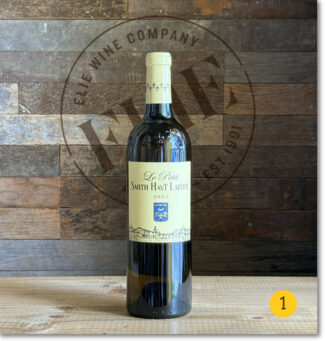 1 Château Smith Haut Lafitte ‘Le Petit Haut Lafitte’, 2022 Pessac-Léognan Blanc ($58)
1 Château Smith Haut Lafitte ‘Le Petit Haut Lafitte’, 2022 Pessac-Léognan Blanc ($58)
80% Sauvignon and 20% Sémillon with a concentrated bouquet melon, honeyed citrus and chamomile; the wine is full-bodied mid-palate but retains a crisp and lyrical intensity all the way to a saline finish.
Domaine de Chevalier
Pessac-Léognan
Grapes may be the stock and trade of Pessac-Léognan, but as a land mass, it is mostly forest. Carved into a clearing in that forest, Domaine de Chevalier has been a mainstay of wine production in the region for hundreds of years. So much do the trees influence the wines that one of the first things Olivier Bernard did when he took over the estate (at the age of 23) in 1983 was removing the sheltering belt that surrounded those acres most susceptible to frost.
At the time, the estate had only 44 acres of vines. Among Bernard’s other early decisions was to retain the winemaking team and enlarge the holding. In 1985, he purchased additional plots from neighboring vineyards; next, he began a long-term replanting program lasting from 1988 to 1995, including in these 17 acres of Sauvignon Blanc and Sémillon.
Today, he is joined in daily operations by his two sons Adrien and Hugo. With 65 acres under vine, divisible into 90 individual plots, the potent Pessac-Léognan terroir is built around gravel with black sand over clay and hardpan soil. There are gentle slopes and elevations throughout the parcel which rise to around 200 feet, relatively high for Bordeaux.
 2 Domaine de Chevalier ‘L’Esprit de Chevalier’, 2022 Pessac-Léognan Blanc ($44)
2 Domaine de Chevalier ‘L’Esprit de Chevalier’, 2022 Pessac-Léognan Blanc ($44)
75% Sauvignon Blanc and 25% Sémillon with a full 18 months of barrel aging; the wine is silky and layered with citrus oil, gooseberries, Key Lime pie and a crisp acidity that turns stony on the finish.
Château Carbonnieux
Pessac-Léognan
In order to keep a healthy vineyard, Château Carbonnieux replants at least one or two plots of vines each year, although it will be many years before they produce fruit suitable for the Carbonnieux label. As such, the younger fruit is bottled under the Tour Léognan name.
Carbonnieux is an estate with which even a casual wine drinker is probably familiar. With more than 420 acres under vine, it is easily the largest vineyard in Pessac-Léognan, and one of the largest in Bordeaux. Its wines are widely available in the United States—especially the whites, since the acreage is evenly divided between red and white; 65% Sauvignon Blanc and 35% Sémillon.
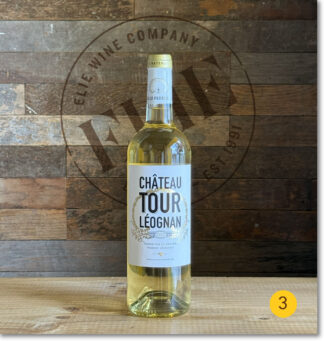 3 Château Tour Léognan, 2022 Pessac-Léognan Blanc ($29)
3 Château Tour Léognan, 2022 Pessac-Léognan Blanc ($29)
65% Sauvignon Blanc and 35% Sémillon, with a light aging in French oak to add some spice and weight. A classic white Bordeaux with a mélange of gooseberry, dried mango, white flowers with crushed stone and a citrus lift on the finish.
Notebook …
The Originality of Pessac-Léognan Lies in Its Origin
That the area now specified as Pessac-Léognan is capable of producing world-class wines has been noted for centuries. The terroir is characterized by deposits of pebbles and gravel that has accumulated via the Garonne River for nearly two million years. The climate is regulated to the east by the river, which mitigates frost, and to the west by the forest, which protects vineyards from the prevailing winds and keeps the soil moist.
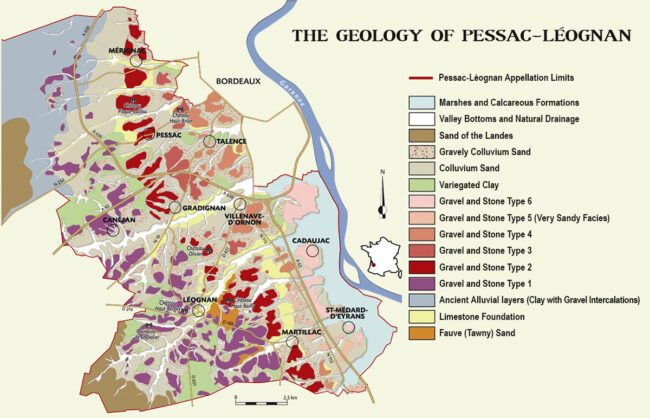
The key features of the appellation include a landscape of low rises that are sufficiently sloping to ensure good drainage, further facilitated by a network of small streams that act as natural drains feeding into the Garonne River; soils consisting of river gravel up to 25 feet deep are set on Tertiary limestone subsoil, both left behind by the river as it changed course during the Quaternary Era. These stones reflect the sun’s radiation, increasing the vines’ sun exposure and accelerating the ripening of the grapes—a combination of factors that represents Pessac-Léognan’s inimitable, inalienable heritage.
Tipping the Scales: Warm Summers and Wet Winters Boost Pessac-Léognan- For Now
Grappling with the pluses and minuses of climate change is a double serving of concern on the plate of every wine region on the planet; Pessac-Léognan is no exception.
First, what we all know to be true: Weather drives wine quality and taste. Temperature and precipitation occurring throughout the year—from bud break, while the grapes are growing and maturing, during harvesting, and even overwintering dormant vines—each play a role. The same vineyard can produce different quality levels in different years despite those wines coming from grapes grown on the same vines, on the same land, and being produced by the same methods.
With climate change upending many of the most predictable weather patterns (even among an otherwise random set of circumstances), a study done by Andrew Wood of the University of Oxford’s Department of Biology paired high-resolution climate data with annual wine critic scores from the Bordeaux wine region in southwest France from 1950 to 2020, and concluded that, “The trend, whether driven by the preferences of wine critics or the general population, is toward stronger wines that age for longer and give you richer, more intense flavor, higher sweetness, and lower acidity. And with climate change generally, we are seeing a trend across the world that with greater warming, wines are getting stronger.”
He adds: “With the predicted climates of the future, given that we are more likely to see these patterns of warmer weather and less rainfall during the summer and more rainfall during the winter, wines are likely to continue to get better. However, there is a tipping point; once water becomes more limited, if plants don’t have enough, they eventually fail. And when they fail, you lose everything.”
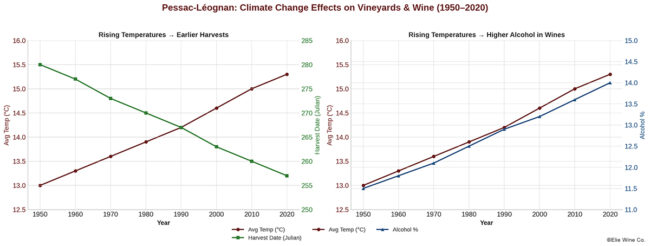
Pessac-Léognan’s ability to adapt and take advantage of this natural phenomenon is largely dependent on the commune in question, since each enjoys varying degrees of temperature modulation, allowing for differences in the levels of ripeness, alcohol, and picking dates. For example, Talence is warmer and there, the vineyards are picked earlier than Pessac, while Martillac harvests after Léognan. Overall, however, Pessac-Léognan is becoming increasingly warmer; 2022 saw the earliest start date for harvesting ever. 2022 was also the first vintage where some vintners requested and were able to irrigate select vines in various parcels due to the parching heat. Alice Leuret, Commercial director at Château Les Carmes Haut-Brion, indicates that irrigation permits required a mountain of paperwork, and at her estate, was restricted to five acres of young vines.
- - -
Posted on 2025.08.23 in France, Wine-Aid Packages | Read more...
Champagne in Three Acts: Vincent Lagille’s Quest for Terroir Clarity Through Single Varietals – With Tension, Timing, and Thoughtful Restraint as His Guides
The quietest revolution Champagne has begun to increase its volume, and the emerging focus on parcel-based wines relying on single varietals to reflect terroir is moving closer to center stage. In a region where blends and house styles has been a hallowed hallmark to ensure homogenized quality, the shift to parcels and monovarietal wines is Champagne’s modern nod to authenticity.
The chief concession made by winemakers who are after this specificity of expression is volume: Parcels in Champagne are the norm (the result of hereditary fragmentation), and they are often quite small. Bottlings from individual plots results in limited production, making these wines rare and sought after. Of course, the exclusivity only adds to their allure.
Enter Vincent Lagille from Vallée de L’Ardre on the western slopes of Montagne de Reims, who has shifted his family’s focus on wine sold only to private customers to a broader, public outreach. Sworn to biodynamic principles, he has been exploring the potential of his family’s vineyards in Treslon, plot by plot, where Meunier is the dominant variety.
Here we feature his monovarietal and site-specific Champagnes as an ideal example of the region’s ‘newthink.’
The Regions of Champagne
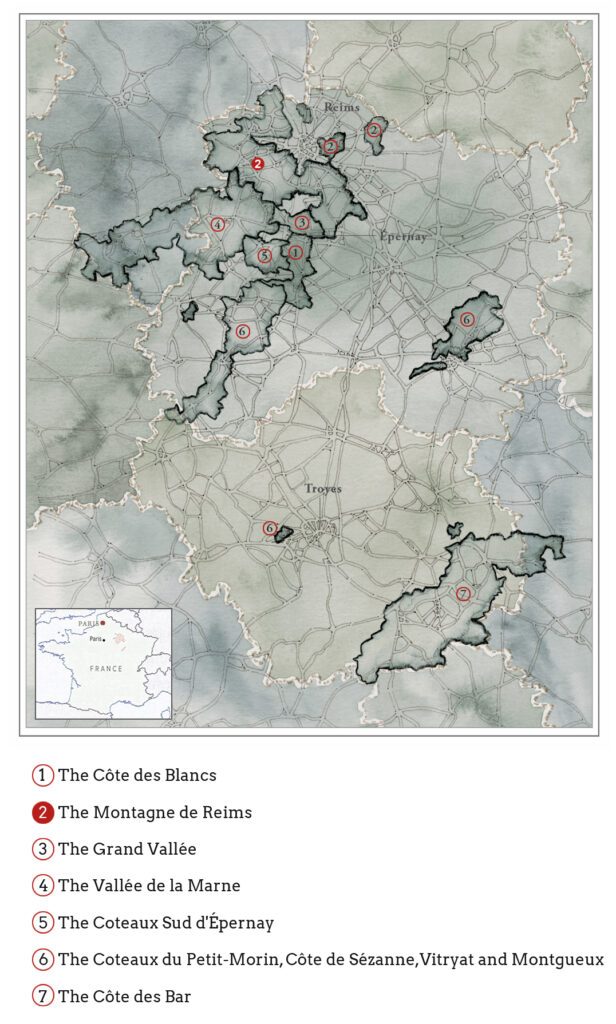
The Petite Montagne: On the Western Edge of Reims, Distinctive Terroir and a Patchwork of Soils and Styles
So varied are the soils, topographies and microclimates of the Montagne de Reims that it is not possible to speak of the region in any unified sense. Grande Montagne de Reims, which contains all of the region’s Grand Cru vineyards, covers the northern, eastern and southern slopes of the viticultural area, and Pinot Noir plantings dominate at 57%, followed by Chardonnay (30%) and Meunier (13%). Its vineyards face a multitude of directions, and soil type varies by village, giving rise to a breadth of Pinot Noir expressions, as well as exceptional Chardonnay.
To the west, the Grande Montagne de Reims gives way to the Petite, whose bedrock is chalk, but softer than the chalk found further south on the Côte des Blancs. This sort, called ‘tuffeau’, is an extremely porous, sand-rich, calcium carbonate rock similar to what is found in wine regions of the middle Loire Valley. In French, the word ‘petite’ often to refers to a ‘lesser’ commodity, but with La Petite Montagne, the reference is to elevation. This lower elevation means warmer weather, even in Champagne’s northerly climate, and in certain villages, the soils contain more sand, making it an ideal environment for growing Meunier.
Meunier accounts for approximately half of the plantings in the Petite Montagne, with Pinot Noir making up 35% and the rest Chardonnay. It is a growing conviction among growers of the modern era that Meunier is a Champagne grape whose time has come, especially as an age-worthy variety. Emmanuel Brochet of Villers-aux-Noeuds says, “People claim that Meunier ages too quickly, even faster than Chardonnay. I disagree. The curve of evolution is different. Meunier is quick to open and more approachable in youth, but then it becomes quite stable. Chardonnay tends to open later, but old Meunier remains very fresh and lively.”
The Villages of The Montagne de Reims

Vincent Lagille
Champagne Domaine Lagille
A Vigneron’s Pursuit of Verticality, Variety, and the Voice of the Vineyard
When asked if he and his sister Maud feel strongly about their roots in Treslon, where their family has been winegrowers since the 17th century, Vincent Lagille responds succinctly: “This is a form of obviousness.”
Maud Lagille adds, “I don’t even know if it would be possible to imagine us anywhere else.”
“We are the ambassadors of Treslon,” Vincent says, “and these wines reflect the terroir of the village. To achieve the truest expression, technique is everything, even when it means experimenting beyond the norm. Our Meunier is cultivated in Cordon de Royat, a system usually reserved for the Grand Cru vineyards of Pinot Noir and Chardonnay. Minimal dosage is our standard and aging is done in barrels that have already been used for up to ten vintages to minimize the influence of oak.”
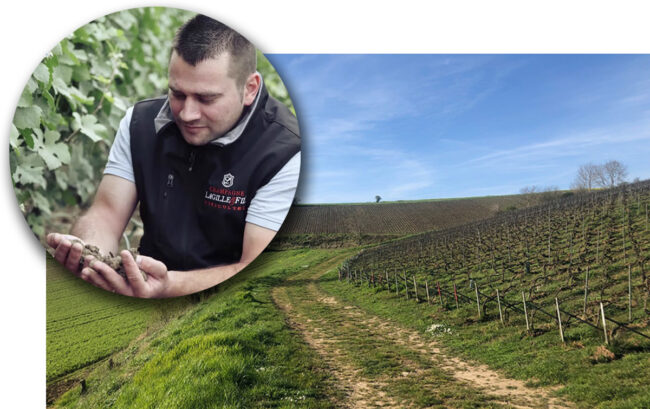
Vincent Lagille, Champagne Domaine Lagille
Treslon nestles in the Vallée de l’Ardre, a stone’s toss from Reims. The Lagille domain covers 18 acres, planted to 55% Meunier, 30% Chardonnay, and 15% in Pinot Noir, and the focus of winemaker Vincent Lagille is on individual expression in a number of parcellaires—lieux-dits—of which he specializes in monovarietal wines. His only blend, in fact, is ‘Cuvée Grande Réserve.’
Pushing the envelope still further, Vincet has been fermenting certain harvests in glass globes and relying on baie par baie (hand-destemming) vinification, a time-consuming method that originated in Nuits-Saint-Georges. Many of these methods, unique to Montagne-de-Reims—were the result of trial and error:
“I fumbled for several years,” he admits, “With Maud and Claire (our second sister who worked with us from 2004 to 2021), we were constantly questioning ourselves. In 2017, I had a click. In connection with training on the issue of soils. It has become crystal clear. I wanted local wines. Wines that tell about our roots. Family roots, but also cultural roots. For this, I wanted the terroir to be able to express itself, for the vine to be able to draw deep into the soil. We have therefore undertaken to modify our cultivation practices. And today, we have made the choice to move towards organic certification.”
Rooted in The Petite Montagne: Treslon’s Singular Voice
The Lagilles may call themselves ‘The Ambassadors of Treslon,’ but in truth, they don’t have a lot of competition. The small community (located on top of the northwestern part of the Montagne de Reims hill where the small stream Ruisseau de Treslon empties into the Ardre river) has only 216 residents and nine grower/producers.
Treslon’s 600 or so vineyard acres are located north and northwest of the village in a band above the road between Faverolles-et-Coëmy and Treslon. They are predominantly south-facing slopes where Meunier is the dominant variety.

One Variety at a Time: Nothing Added, Nothing Lost
Hand-in-hand with single-vineyard Champagne goes single-variety cuvées, and despite the region’s historical reliance on blends, single-grape wines are a lens that can magnify site expression and vintage transparency. Without the layering effect of blending, the grape’s natural structure and tension take center stage.
“I think that’s really our thing,” says Vincent Lagille when asked about single-variety cuvées. “Only our Cuvée Grande Réserve is a blend. For the rest, the choice is clear to allow the expression of our terroir through each grape variety individually.”
To achieve this goal required a lot of research and observation on his part, and years of field work: “I followed the harvest circuit, when the collection of grapes takes place exactly when they are the most interesting. I learned to walk around my vines several times, so that I do not to miss the best moment. I’ like to collect the Meuniers at around 10.5 degrees [brix], while Pinots Noirs are just amazing at 11.5 degrees. For Chardonnays, it’s different. It varies more depending on years and plots.”
Les Bergères, La Garenne and Le Mont en Peine are the parcels that he finds most inspirational and he treats them differently than the rest of his range after harvest, especially through use of a technique known as fractionation. This involves altering the pressure at various times to fractionalize the quality and properties of the grape juice: First juice, for example, is released with minimal pressure and is considered the highest quality with delicate flavors, aromas and a good balance of sugar and acidity. As pressure increases, more juice is extracted, potentially containing more phenolics, including tannins.
From there, it is down to cellar technique, including minimal dosage, passage in barrels and the never-ending search for tension in the wines and plots. Vincent says, “I start with what I love. For example, regarding chaptalization, I always explain that I am a huge tea lover, and as such, I never put sugar in it. For me, that masks the essence of the product.”
And when it comes to wine, that mask is something that Vincent has dedicated his entire professional life to removing.
Shaped by Clay, Ready for Respect: The Reappraisal of Meunier
Most of the Meunier in Montagne-de-Reims (which accounts for about 34% of its vineyards) is planted to the west, towards Vallée de la Marne, though it remains an important blending component throughout the region.
Across Champagne in general, it’s a variety whose qualities are being reconsidered: Early to bud and early to ripen, it is a practical grape, but in the correct hands it produces nicely structured and age-worthy wines which remain approachable on release, The top producers are from Premier sites rather than Grand Crus.
Meunier thrives in the argilo-calcaire (clay/limestone) soils where Pinot Noir falters, especially on the cooler slopes of the Vallée de la Marne and the Petite Montagne. When fully ripe, Meunier produces wines that are fruitier and more ample when young, which is why it’s often blended in nonvintage Champagnes intended for early consumption.
 Champagne Domaine Lagille ‘L’Inattendue’, Montagne-de-Reims ‘Village Treslon’ Blanc-de-Noirs Extra-Brut ($67)
Champagne Domaine Lagille ‘L’Inattendue’, Montagne-de-Reims ‘Village Treslon’ Blanc-de-Noirs Extra-Brut ($67)
The name means ‘unexpected,’ and that’s because the cuvée is a unicorn—a rare example of a single-varietal, entry-level Champagne made purely of the Meunier. The wine aged for three years before disgorgement and was given a low dosage of around 2 grams per liter. It displays vibrant fruit, elegant acidity and a savory finish.
Disgorged in December 2024.
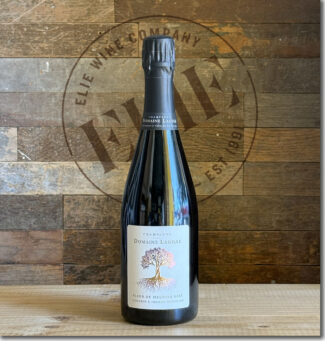 Champagne Domaine Lagille ‘Fleur de Meunier’, Montagne-de-Reims ‘Village Treslon’ Rosé Extra-Brut ($73)
Champagne Domaine Lagille ‘Fleur de Meunier’, Montagne-de-Reims ‘Village Treslon’ Rosé Extra-Brut ($73)
100% Meunier, this rosé is crafted through cold maceration of hand-selected grapes, then fermented in both fût de chêne and stainless steel, following which it remains on its lees for five years. Dosage is limited to 3 grams per liter, balancing freshness and structure. The wine shows a nose of red currant and raspberry with a citrus undertone; the bead is extremely fine.
Disgorged in November 2024.
Champagne’s Chameleon: Pinot Noir in All Its Vigor, Deeply Site-Specific
Within Montagne de Reims, Pinot Noir is the most widely planted grape, some standing on its own but most a vital component in blends. Pinot Noir in Champagne is much different than Pinot Noir in Burgundy, being lighter-bodied, virtually tannin-free, producing floral, red-fruit notes often subsumed into long lees aging. On chalk-limestone soils—which is where Chardonnay is usually planted—Pinot Noir is delicate, elegant and vibrant; on clay soils, the wines become heavier. On the western edge of Montagne de Reims there are sandy soils, though these plots often contain Meunier. Many vineyards have a mixture of soils, so it’s important for the grower/producer to understand exactly where the fruit is being grown.
 Champagne Domaine Lagille ‘Les Bergères’, 2020 Montagne-de-Reims ‘Village Treslon’ Blanc-de-Noirs Brut-Nature ($126)
Champagne Domaine Lagille ‘Les Bergères’, 2020 Montagne-de-Reims ‘Village Treslon’ Blanc-de-Noirs Brut-Nature ($126)
One of four brut natures in the domain’s parcellaire collection, ‘Les Bergères’ (The Shepherdesses) is a plot of 40-year-old-vine Pinot Noir that Vincent calls ‘Pinot of the Sun’ due to the plot’s southern exposure. “Les Bergères is 300 meters from our premises,” he says, “It has always been exceptional, rarely affected by diseases or parasites”
The wine shows sweet notes of plum tarts and ripe drupes with a refreshing and persistent roundness, and a fresh saline finish. Great structure, balanced minerality and a persistent, fruity finish.
Disgorged in November 2024. A total of 1,780 bottles were released. No dosage.
Chalk and Citrus: Chardonnay’s Minerality and the Promise of Time
Although Montagne de Reims is mostly associated with red grapes, 25% of production is Chardonnay. It’s planted in pockets across Montagne de Reims, in styles quite distinct from Côte des Blancs further to the south, and even produces a still, skin-contact wine under the Coteaux Champenois appellation. Chardonnay is an earlier budder than Pinot Noir, making spring frost an issue. It remains an indispensable blending grape, despite facing several challenges: It is thin-skinned, for example, making it susceptible to botrytis, which can be a problem with Champagne’s wet weather. In its most classical incarnation, Chardonnay creates a citrusy wine of high acidity marked by chalky minerality.
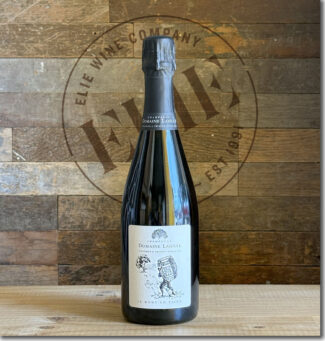 Champagne Domaine Lagille ‘Le Mont-en-Peine’ 2021 Montagne-de-Reims ‘Village Treslon’ Brut-Nature ($126)
Champagne Domaine Lagille ‘Le Mont-en-Peine’ 2021 Montagne-de-Reims ‘Village Treslon’ Brut-Nature ($126)
100% Chardonnay from the Le Mont-en-Peine vineyard—the illustration on the label depicts Vincent as a child lugging around a wine barrel. The bouquet shows lemon curd, green apple, grapefruit and salted caramel; the palate leans toward lime peel and brioche with energetic acidity and a crisp finish.
Disgorged in October 2024. Only 1,504 bottles were produced without dosage.
Notebook …
Champagne’s Vin de Lieu: A Shift Toward Site and Identity
For a wine region that is a day-trip away from Burgundy, Champagne has showed a historical reluctance to focus on lieux-dits—vineyard-specific wines. In fact, Champagnes named for a particular village has been a rarity; Eugène Salon did it in 1905, and however legendary his Côte des Blancs has become, it was decades before anybody else did it, at least for public consumption.
But things are changing in Champagne—climate and zeitgeist, and the torch is being passed to a younger generation. In the 1990s, interest in experimentation took hold, and part of that innovative spirit involved the recognition that sites have personality—something that Champagne houses have long been obsessed with displaying. Blends can achieve a generic identity recognizable from vintage to vintage, and it is unlikely that single-cru models will replace this hegemonic tradition. But a new crop of chefs de cave in Champagne are also increasingly aware that consumers have become interested in a more focused reading of terroir and that by attempting to express their vineyards with individuality rather than synergy when blended with others, an entirely new breed of wine-lovers will be engaged—those who recognize that any wine’s primary identity is drawn from the vine, not the label.
A Matter of Geography: Drawing the Lines, Defining the Regions of Champagne
To be Champagne is to be an aristocrat. Your origins may be humble and your feet may be in the dirt; your hands are scarred from pruning and your back aches from moving barrels. But your head is always in the stars.
As such, the struggle to preserve its identity has been at the heart of Champagne’s self-confidence. Although the Champagne controlled designation of origin (AOC) wasn’t recognized until 1936, defense of the designation by its producers goes back much further. Since the first bubble burst in the first glass of sparkling wine in Hautvillers Abbey, producers in Champagne have maintained that their terroirs are unique to the region and any other wine that bears the name is a pretender to their effervescent throne.
Having been defined and delimited by laws passed in 1927, the geography of Champagne is easily explained in a paragraph, but it takes a lifetime to understand it.
Ninety-three miles east of Paris, Champagne’s production zone spreads across 319 villages and encompasses roughly 85,000 acres. 17 of those villages have a legal entitlement to Grand Cru ranking, while 42 may label their bottles ‘Premier Cru.’ Four main growing areas (Montagne de Reims, Vallée de la Marne, the Côte des Blancs and the Côte des Bar) encompass nearly 280,000 individual plots of vines, each measuring a little over one thousand square feet.
The lauded wine writer Peter Liem expands the number of sub-regions from four to seven, dividing the Vallée de la Marne into the Grand Vallée and the Vallée de la Marne; adding the Coteaux Sud d’Épernay and combining the disparate zones between the heart of Champagne and Côte de Bar into a single sub-zone.
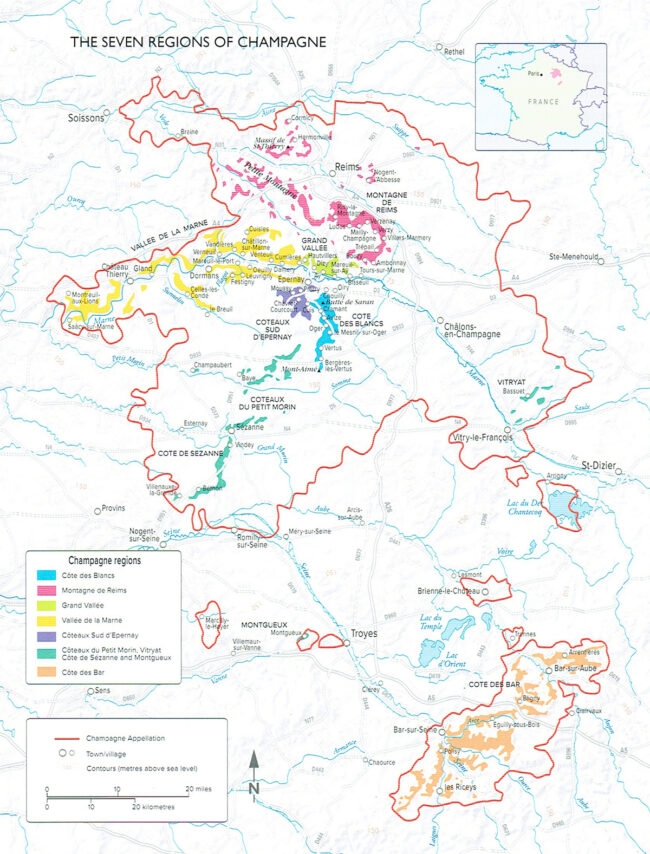
Lying beyond even Liem’s overview is a permutation of particulars; there are nearly as many micro-terroirs in Champagne as there are vineyard plots. Climate, subsoil and elevation are immutable; the talent, philosophies and techniques of the growers and producers are not. Ideally, every plot is worked according to its individual profile to establish a stamp of origin, creating unique wines that compliment or contrast when final cuvées are created.
Champagne is predominantly made up of relatively flat countryside where cereal grain is the agricultural mainstay. Gently undulating hills are higher and more pronounced in the north, near the Ardennes, and in the south, an area known as the Plateau de Langres, and the most renowned vineyards lie on the chalky hills to the southwest of Reims and around the town of Épernay. Moderately steep terrain creates ideal vineyard sites by combining the superb drainage characteristic of chalky soils with excellent sun exposure, especially on south and east facing slopes.
… Yet another reason why this tiny slice of northern France, a mere 132 square miles, remains both elite and precious.
RECENT ARRIVAL
From Beaujolais’s Northern Frontier
The Cru That Doesn’t Conform
Juliénas, named for Julius Caesar, often gets the sort of dismissal as the Roman leader did on the Ides of March. Small, and with a somewhat noncohesive identity born of inconsistent terroirs, Juliénas soils are transitional, ranging from granite further up in the hills to the west to more sedimentary and alluvial soil in the east nearer the river. The ground contains a lot of clay, making irrigation unnecessary (and illegal), but resulting in wines that can be heavy and short-lived.
To succeed in Juliénas, a winemaker needs to be in perfect sync with the environment and consider stepping outside the box a bit in technique and foresight. Clément Beaupère is such a man. His rethinking of vine spacing and his willingness to shake up the ‘established’ approach in a hidebound Cru is making delicious purple waves.
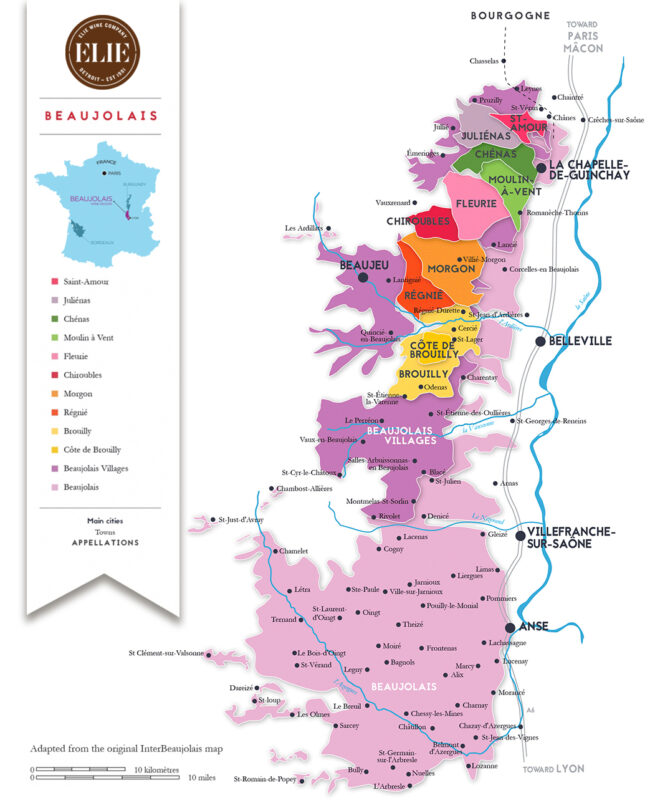
Juliénas: The Structured Side of Beaujolais
Juliénas, at the northern end of the Crus, is also among the most elevated. Slopes are steep, but this verticality is ideal for sunshine basking, allowing grapes to ripen easily here, giving the wines more flesh and backbone. The terroir is as varied as any in a single Cru, with less granite and more ‘blue stone’—a friable, decomposed volcanic schist that the locals call ‘terre pourrie’, or ‘rotten rock.’ The many soils of Juliénas produce such an array of wines that there is no true Juliénas style, although they can be counted on to display a heart of stone and a soul of fresh forward fruit.
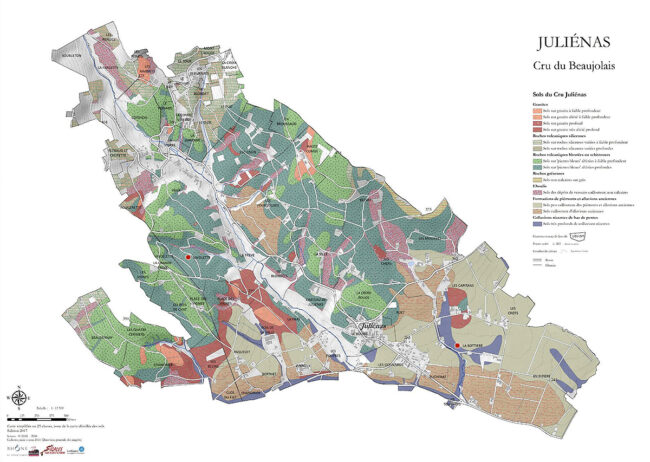
Vintage Report | Beaujolais 2023: Expressive, Balanced and Built to Last
As was the case throughout Beaujolais, Juliénas had a beautiful 2023 with many of the wines showing promise. The growing season kicked off with a mild winter and a somewhat haphazard spring where days ricocheted between unseasonably warm and unseasonably cool. There was no frost, however, and both budbreak and flowering were reasonably successful. The summer months were warm and very dry, although in the north, drought was less a concern. Harvest took place early September and wrapped up towards the end of the month; the grapes, for the most part, were perfectly ripe and nicely balanced.
Domaine David-Beaupère
Crafting Juliénas from the Ground Up, in Concrete
When an engineer takes over a vineyard, you wind up with a lot of math equations, and such is the case with Louis-Clément David Beaupère. After leaving his agricultural engineering studies at ISARA to take over the family’s ten acre domain, he says, “My goal is to reduce planting density significantly as to be able to trellis the vines and move away from the goblet vine training style of Gamay so ubiquitous in the region. Goblet vine training leads to overlapping positions on the vine and therefore uneven ripening of the fruit. As it stands, my yields average around 40-45 hectoliters per hectare which I intend to maintain while reducing the amount of vines per hectare.”
Got it?
In any case, Clément (as he prefers to be called) took over the estate in 2008. His grandfather, who raised his family in Algeria, had purchased the vineyard in 1962 after the Algerian War of Independence, but sold the grapes to the local co-op rather than bottle his own label. Clément’s father named the estate, but it did not reach its true potential until Clément began the long and arduous process of converting the vines to organic and shifting to natural processes in the cellar.

Domaine David-Beaupère
The winery is surrounded by La Bottìere, one of Juliénas’ most prized climats. Like Bottìere, Domaine David-Beaupère’s vineyard is planted on a mix blue diorite, richer soils and a lack of granite (in contrast to much of Beaujolais.) Beaupère vines are over 70 years old.
The other major Beaupère holding is the steep slope of Vayolette—atypical of Juliénas, with poor, stony soil and increases his holdings to just under thirty acres. “I love working with these two rather distinct vineyards,” Clément says. “It allows me to capture a fuller range of the expressions that Juliénas is capable of offering.”
A lot of that Juliénas expression is coaxed out in the cellar. In the cellar, Clément works naturally and in the tradition of many of the region’s greats: Long whole bunch macerations in concrete tanks followed by 8-9 months aging in a combination of very old barrels and tanks. The wines are never filtered, and a small amount of Sulfur Dioxide (SO2) is added, although he has begun to experiment with no-sulfur cuvées in recent years.
These wines are charming and can certainly be consumed young, but their underlying strength, structure and deep complexity means that they can benefit from a few years in the cellar.
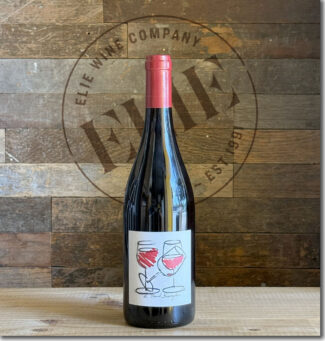 Domaine David-Beaupère, 2023 Juliénas ($42)
Domaine David-Beaupère, 2023 Juliénas ($42)
Clément’s entry-level Juliénas is a beautiful example of the purity and terroir reflection that he brings to every bottle. Ripe with concentrated dark cherry, cassis and baking spices, the palate shows both tar and violets wrapped in bright acidity and smooth tannins.
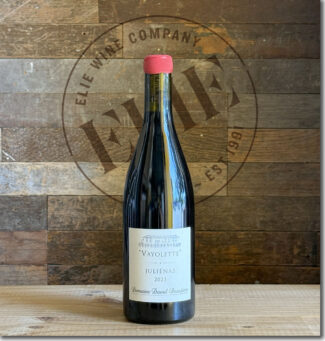 Domaine David-Beaupère, 2023 Juliénas ‘Vayolette’ ($64)
Domaine David-Beaupère, 2023 Juliénas ‘Vayolette’ ($64)
From Clément’s nine-acre parcel in Vayolette climat where 45 year old Gamay vines are farmed organically, hand-harvested and allowed a 25-day maceration in concrete vats before pressing, and then ages in neutral barrels for nine months. Like the slope on which the vineyard is located, the wine is angular and structured, showing plum, raspberry and pomegranate behind brisk acidity and soft tannins. This is a wine capable of cellaring for several years.
 Domaine David-Beaupère ‘Jules Chauvet’, 2023 Beaujolais-Villages ($37)
Domaine David-Beaupère ‘Jules Chauvet’, 2023 Beaujolais-Villages ($37)
Clément works two vineyards in La Chapelle-de-Guinchay; the smaller is an old parcel of Jules Chauvet’s, who was born here. Chauvet, often referred to as the Godfather of Natural Wine, advocated for low-intervention winemaking—techniques which Clément also employs. The wine is floral and expressive with red cherries and plums with appealing spice on the finish.
 Domaine David-Beaupère ‘Let The People Faire La Teuf’ 2023 VdF Beaujolais ‘Gamay’ ($30)
Domaine David-Beaupère ‘Let The People Faire La Teuf’ 2023 VdF Beaujolais ‘Gamay’ ($30)
“Let the People Party” sounds like a battle cry from a rock band. Fermented and aged in concrete in order to highlight its fresh and vibrant character, this Vin de France (VdF) is no simple table wine, but rather an example of a pure and tart Gamay with notes of cranberry, rhubarb and a touch of clove.
 Domaine David-Beaupère, 2023 Moulin-à-Vent ‘Chassignol’ 1.5 Liter ($120)
Domaine David-Beaupère, 2023 Moulin-à-Vent ‘Chassignol’ 1.5 Liter ($120)
Clément took over a steep Moulin-à-Vent vineyard called ‘Chassignol’ planted in the 1950s, some of which he has torn up to plant according to his preferred spacing, planting grass between rows to slow erosion. The wine is ripe and rich with nice structure with notes of red currant, licorice, tar, graphite and baking spice.
- - -
Posted on 2025.08.08 in Juliénas, France, Beaujolais, Champagne, Wine-Aid Packages | Read more...
Featured Wines
- Notebook: A’Boudt Town
- Saturday Sips Wines
- Saturday Sips Review Club
- The Champagne Society
- Wine-Aid Packages
Wine Regions
Grape Varieties
Aglianico, Albarino, Albarín Blanco, Albarín Tinto, Albillo, Aleatico, Arbanne, Arcos, Aubun, Barbarossa, barbera, Beaune, Biancu Gentile, bourboulenc, Cabernet Franc, Cabernet Sauvignon, Caino, Caladoc, Calvi, Carcajolu-Neru, Carignan, Chablis, Chardonnay, Chasselas, Clairette, Corvina, Counoise, Erbamat, Ferrol, Frappato, Friulano, Fromenteau, Garnacha, Garnacha Tintorera, Gewurztraminer, Godello, Graciano, Grenache, Grenache Blanc, Grolleau, Groppello, Juan Garcia, Lambrusco, Loureira, Macabeo, Macabou, Malbec, Malvasia, Malvasia Nera, Marcelan, Marsanne, Marselan, Marzemino, Mondeuse, Montanaccia, Morescola, Morescono, Moscatell, Muscat, Natural, Nero d'Avola, Parellada, Patrimonio, Pedro Ximénez, Petit Meslier, Petit Verdot, Pineau d'Aunis, Pinot Blanc, Pinot Gris, Pinot Meunier, Pinot Noir, Pouilly Loche, Poulsard, Prieto Picudo, Riesling, Rondinella, Rose, Rousanne, Roussanne, Sauvignon Blanc, Savignin, Sciacarellu, Semillon, Serine, Souson, Sparkling, Sumoll, Sylvaner, Syrah, Tannat, Tempranillo, Trebbiano, Trebbiano Valtenesi, Treixadura, Trousseau, Ugni Blanc, vaccarèse, Verdicchio, Vermentino, Xarel-loWines & Events by Date
- September 2025
- August 2025
- July 2025
- June 2025
- May 2025
- April 2025
- March 2025
- February 2025
- January 2025
- December 2024
- November 2024
- October 2024
- September 2024
- August 2024
- July 2024
- June 2024
- May 2024
- April 2024
- March 2024
- February 2024
- January 2024
- December 2023
- November 2023
- October 2023
- September 2023
- August 2023
- July 2023
- June 2023
- May 2023
- April 2023
- March 2023
- February 2023
- January 2023
- December 2022
- November 2022
- October 2022
- September 2022
- August 2022
- July 2022
- June 2022
- May 2022
- April 2022
- March 2022
- February 2022
- January 2022
- December 2021
- November 2021
- October 2021
- September 2021
- August 2021
- July 2021
- June 2021
- May 2021
- April 2021
- March 2021
- February 2021
- January 2021
- December 2020
- November 2020
- October 2020
- September 2020
- August 2020
- July 2020
- June 2020
- May 2020
- April 2020
- March 2020
- February 2020
- January 2020
- December 2019
- November 2019
- October 2019
- September 2019
- August 2019
- July 2019
- June 2019
- May 2019
- April 2019
- March 2019
- February 2019
- January 2019
- December 2018
- November 2018
- October 2018
- September 2018
- August 2018
- July 2018
- June 2018
- May 2018
- April 2018
- March 2018
- February 2018
- January 2018
- December 2017
- November 2017
- October 2017
- September 2017
- August 2017
- July 2017
- June 2017
- May 2017
- April 2017
- March 2017
- February 2017
- January 2017
- December 2016
- November 2016
- October 2016
- September 2016
- August 2016
- July 2016
- June 2016
- May 2016
- April 2016
- March 2016
- February 2016
- January 2016
- December 2015
- November 2015
- October 2015
- September 2015
- August 2015
- July 2015
- June 2015
- May 2015
- April 2015
- March 2015
- February 2015
- January 2015
- December 2014
- November 2014
- October 2014
- September 2014
- August 2014
- July 2014
- June 2014
- April 2014
- March 2014
- February 2014
- January 2014
- December 2013
- November 2013
- October 2013
- September 2013
- August 2013
- July 2013
- June 2013
- May 2013
- April 2013
- March 2013
- February 2013
- January 2013
- December 2012
- November 2012
- October 2012



